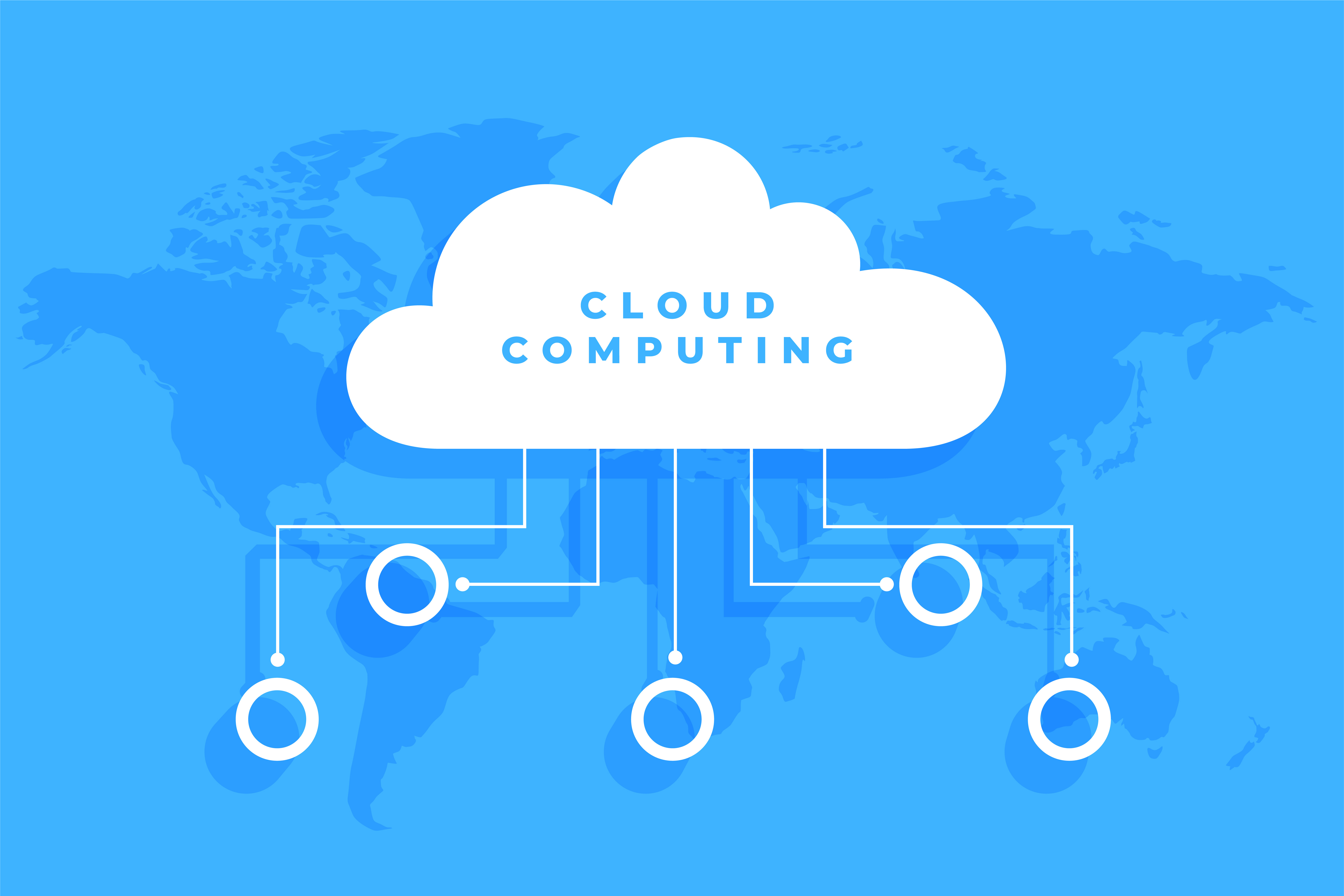
Objectives :
- Learn the fundamentals of accounting
- Understand the different models CAPEX, OPEX, TCO
- Understand the different phases of a cloud migration roadmap
- Understand the 7 cloud migration strategies (7Rs)
- Learn more about the CCOE (Cloud Center of Excellence)
- Learn from cloud migration failures examples
- Learn from realworld business use cases
Cloud Migration

The Problem
Your company is pretty well established, you offer services and products to your customers and everything seems to be running just fine.
You've recently heard about the benefits and cost savings of migrating to the cloud.
Your business is running smoothly but nothing guarantees that your services/products will still be relevant for your customers in the future.
Also, your direct concurrent has actually migrated some of their assets to the cloud and they seem to have saved a lot of money, and they progressively lower the costs of their services and products.
Your products/services are significantly better, but you can't risk waiting and do nothing. You understand that the cloud can offer a strategic advantage by conducting cost-effective experiments and delivering your products/services to the market faster..
Your next challenge is to determine whether migrating to the cloud is worthwhile, and to identify the indicators and metrics that can help you.
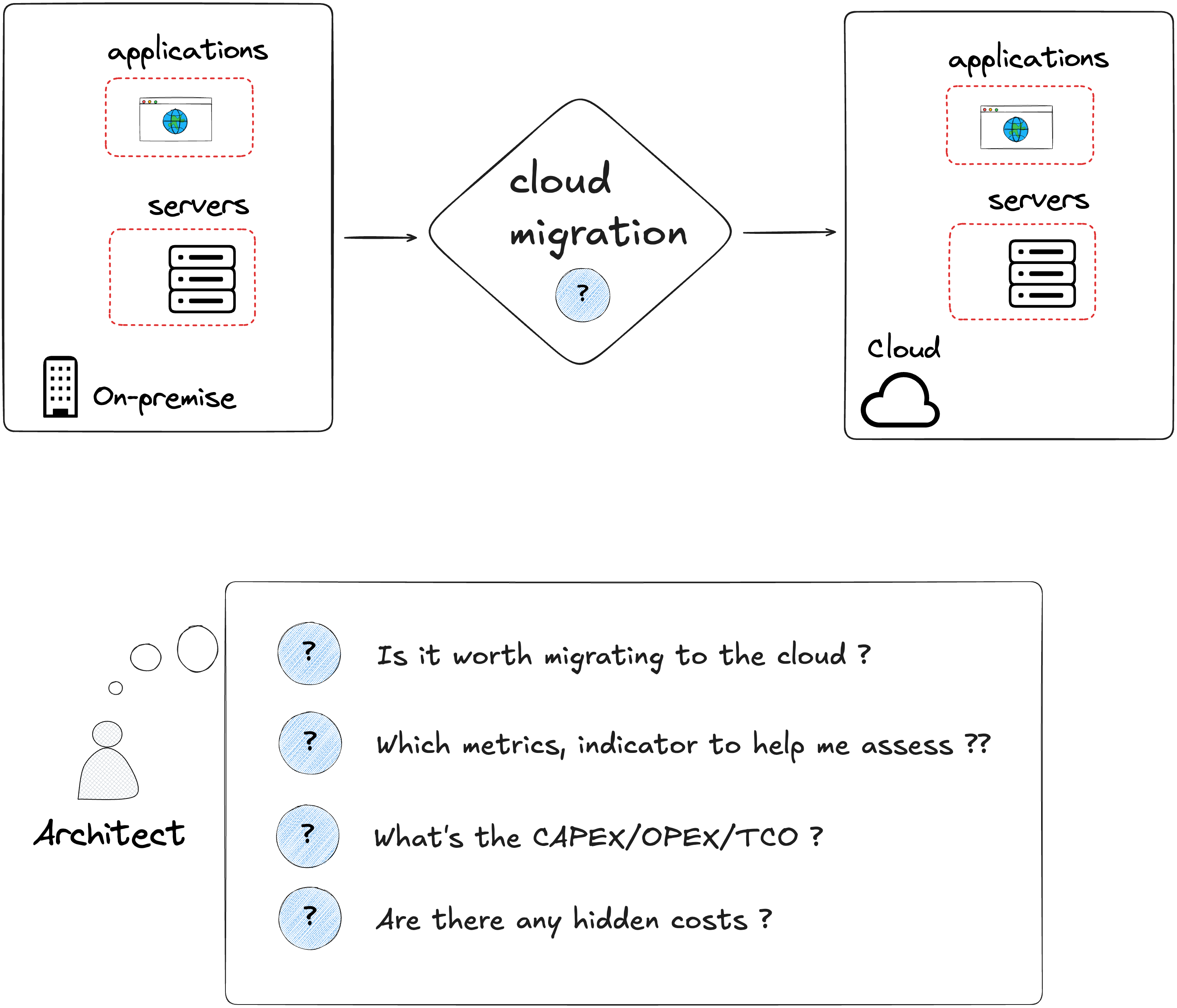
Accounting 101 - Basics
Before migrating to the cloud, you probably need to make an assessment of your current financial situation. You probably want to understand if there will be a return on your investment.
Your company is probably selling products or services, and as every companies, you need to keep track of your incomes and expenses (also known as accounting)
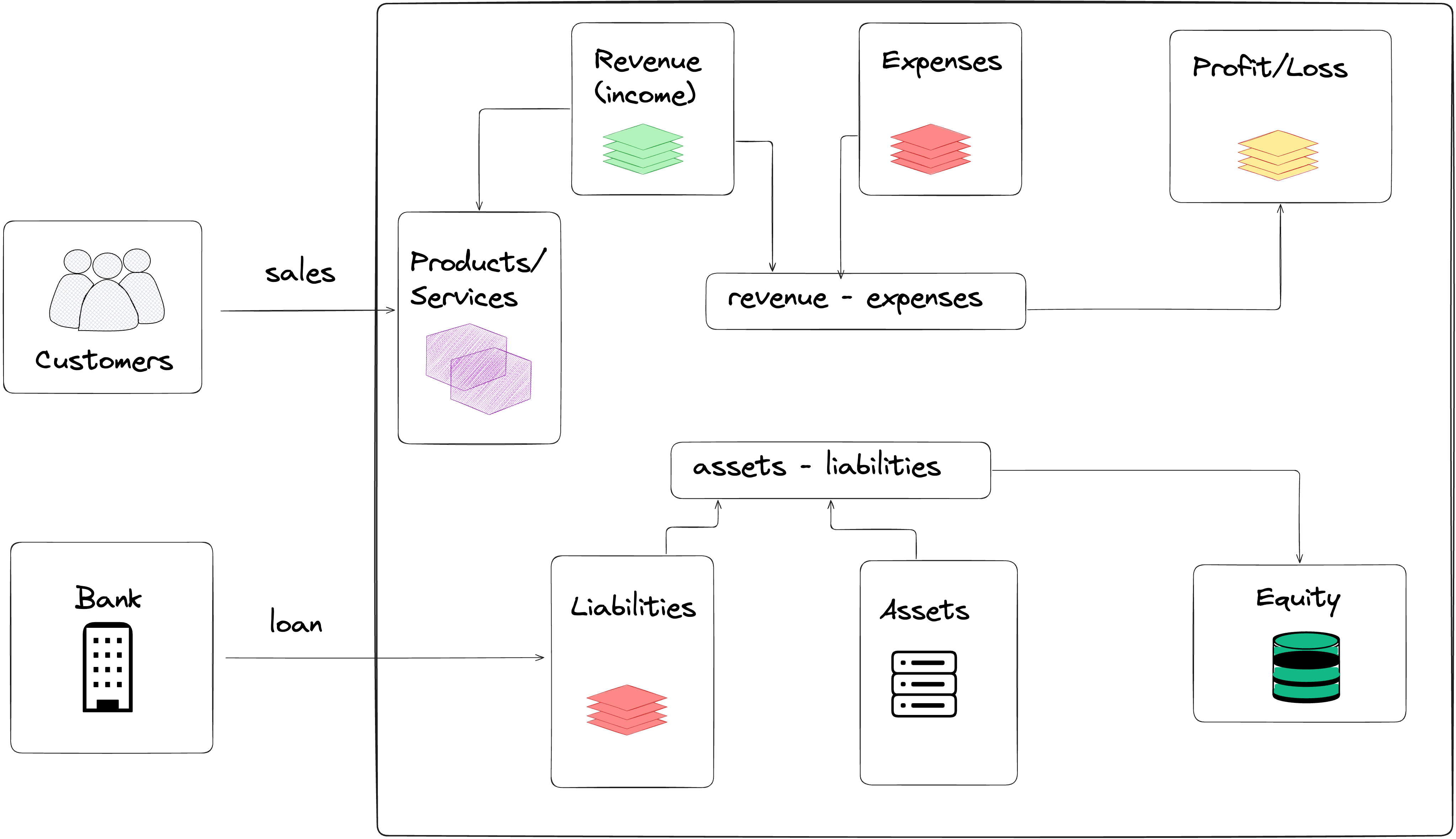
Accounting helps you understand how well your business is doing and you can anticipate, correct and plan more efficiently your activities.
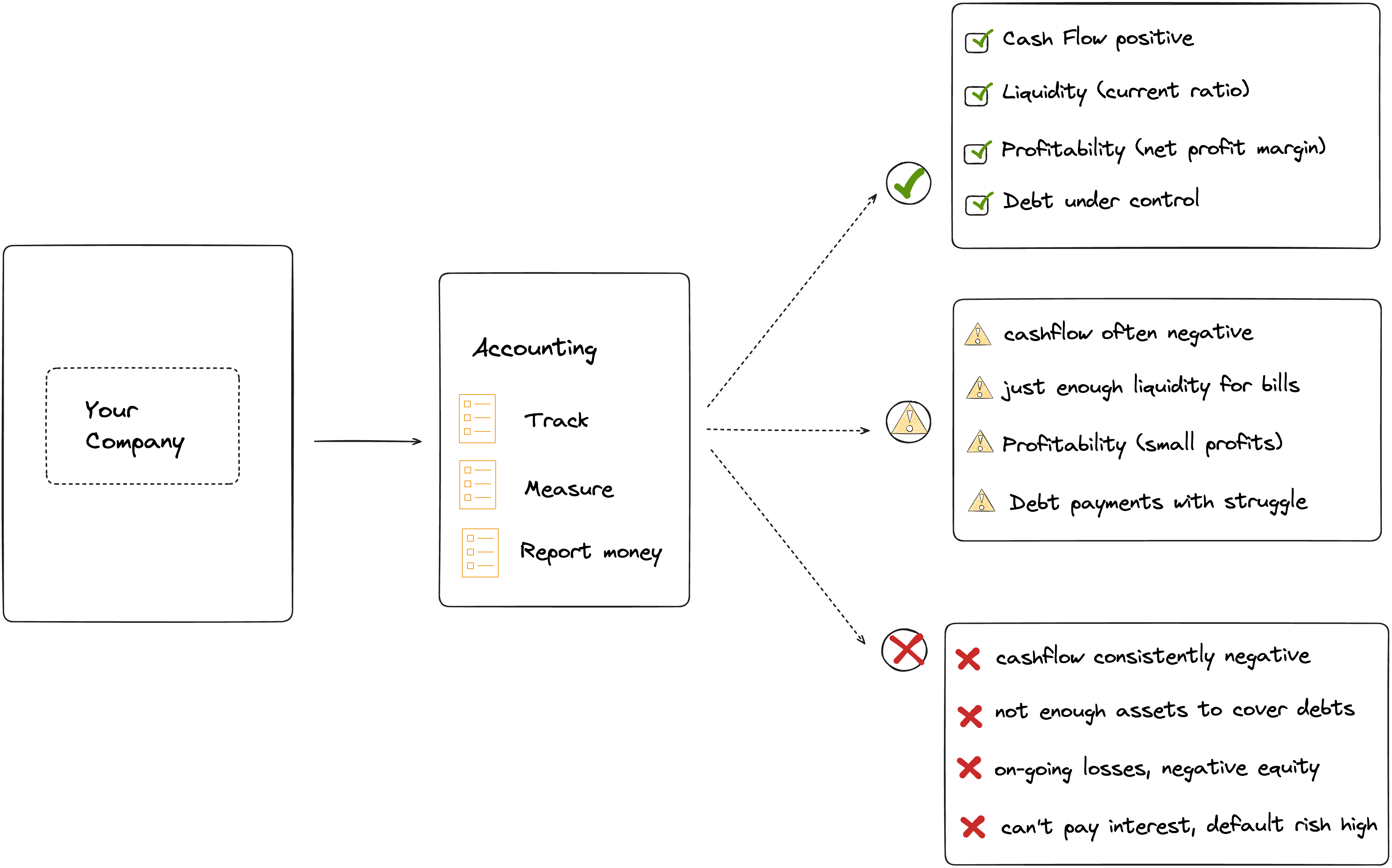
Here is a table with more details
| Accounting Terms | Description | Examples |
|---|---|---|
| Revenue (Income) | The money that you earn from selling your products and services |
Your company is offering streaming services to its customers, each customer pay 15$/month. You have 1000 customers (15$ x 10000 = 150000$). Your total revenue per month is 150 000$ |
| Expenses | The money you spent to run your business |
You spend money on server costs, paying employees or bills (electricity, etc ..) Total expenses = 60 000$ |
| Profit (or Loss) | What’s left after expenses are deducted from revenue. |
150 000$ (Revenue) - 60 000$ (Expenses) = 90 000$ (Profit) |
| Assets | What’s the company owns and that has value |
The company owns servers and has rights to stream certain shows worth 50 000$ |
| Liabilities | What’s the company owes (debt) |
The company borrowed 20 000$ from a bank = 20 000$ liability |
| Equity | The owners' share after subtracting liabilities from assets |
50 000$ assets - 20 000$ liabilities = 30 000$ equity |
There are 3 main reports to understand your financial situation (in accounting):
Income statement
Balance Sheet
Cash Flow Statement
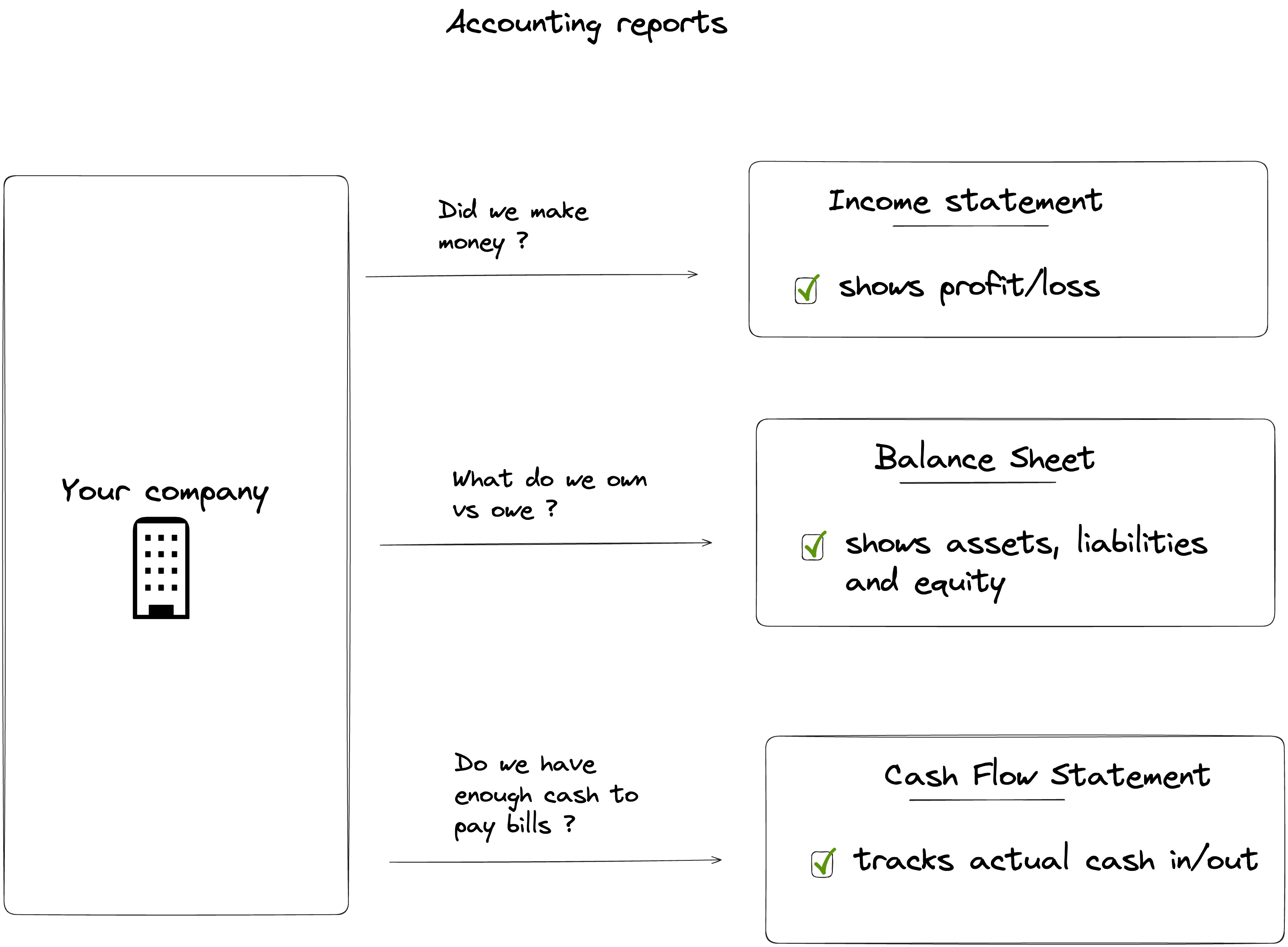
CAPEX vs OPEX
CAPEX (Capital Expenditure) is when you're buying big and long term assets. This asset will be depreciated over a period of 5 years. It's usually the model you choose when you run your services on-premises (your own datacenter, etc ..)
Example : You buy servers worth 50 000$, it's not treated as an expense, instead, it will be put on the balance sheet, the cost is spread out over 5 years through depreciation. 10 000$ every year.
OPEX (Operational Expenditure) is the day-to-day running costs. It's also a model adopted when you use cloud services (on-demand workload and pay as you go).
Example : You pay cloud services (servers on demand) for 3000$ /month
Let's assume that your streaming service company is running just fine, more and more users subscribe, your projection is to have a 50% growth every year for the next 5 years.
You need to make new investments to absorb the growing demands. You have 2 options :
Option 1 : Invest in CAPEX, purchase new on-premise servers
Option 2 : Invest in OPEX, continue your scaling with cloud services
Which option will you choose ?
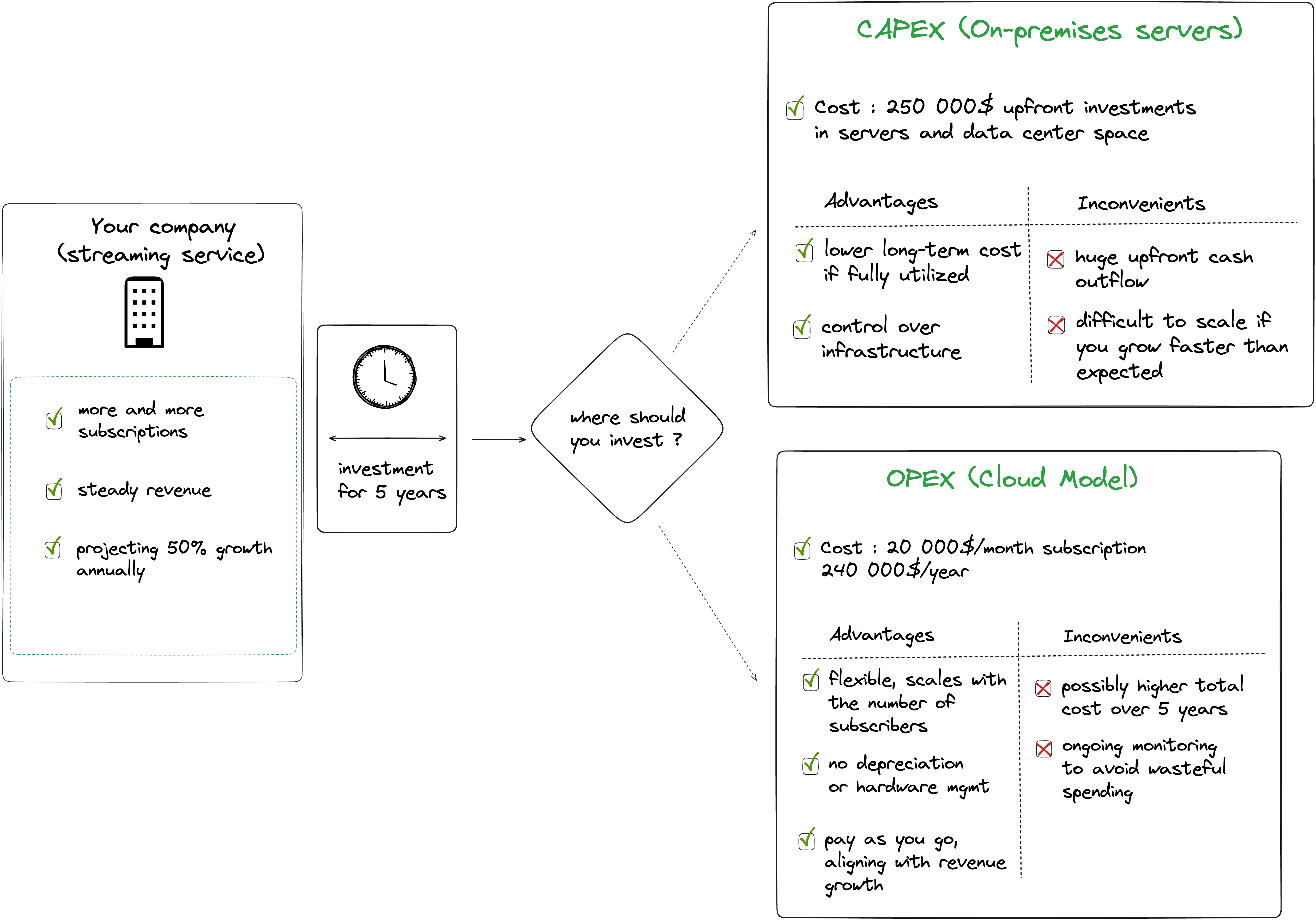
TCO
In some scenarios choosing the OPEX model might be more expensive than the CAPEX model in the long term, but it's important to understand and add another concept
TCO (Total Cost of Owernship) : it's the the sum of all costs of owning and operating an IT systems over its lifecycle, and not just the purchase price.
The TCO includes the following costs :
Direct costs : Hardware, software licenses, subscriptions
Indirect costs : Electricity, cooling, physical space
Operational costs: Staff salaries (system admins, IT support).
Hidden costs : Downtime, upgrades, training, security, compliance.
Companies often underestimate the total cost of owernship, especially by not including the hidden costs, which can significantly make the Cloud cheaper and less expensive
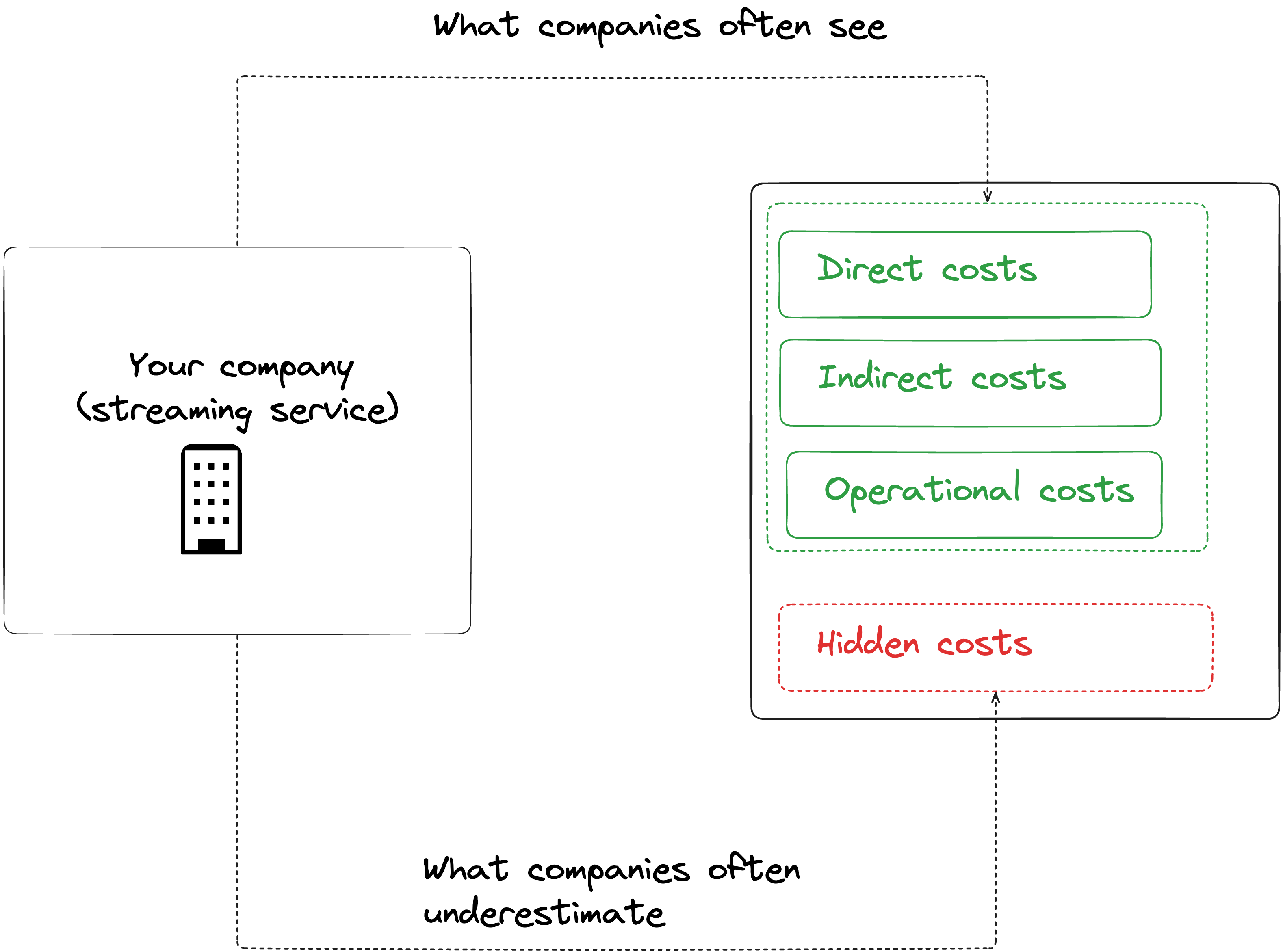
Return on Investment (ROI)
Based on the TCO analysis, you can certainly start to have a clear picture on your investment, and whether it's worth migrating or using cloud services.
Here is the basic formula to calculate your ROI :

Example using CAPEX

Example using OPEX

There are elements affecting the ROI (Return on Investment):
Preparing and planning : the better you prepare and analyze the costs, the better you can plan with more accuracy, like right-size your workloads, etc..
Workload : if you're running static workloads with no peak, it's easier to migrate with cost savings.
Existing on-prem costs : if your existing costs (on-prem hardware, maintenance, cooling, staff, power) are already high, migrating to the cloud will certainly won't provide significant ROI. If you're lean in your on-prem expenses, it's a good starting point.
Ongoing optimization : When you migrate to the cloud, it's critical to keep managing costs, deprecate unused services and optimize usage.
Hidden costs : There are always hidden costs, like if you want to refactor your apps, training staff, the cost of data transfer, the regulatory compliance, etc ..
Cloud Migration Roadmap
Your cloud migration is a risky bet, to lower the risks, it's important to understand the roadmap and all the phases. There are 7 main steps :
Strategy and Planning
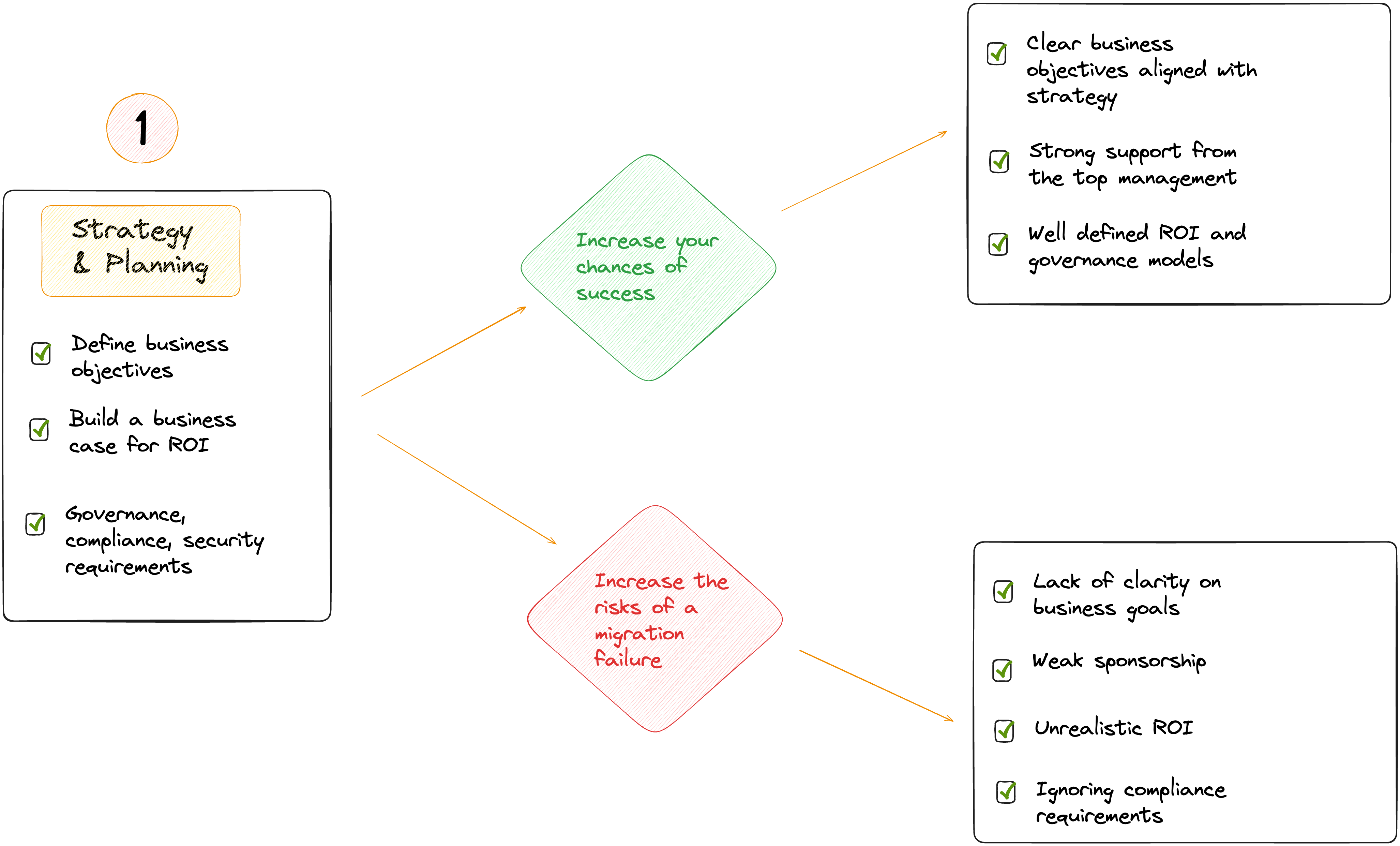
Assessment & Discovery
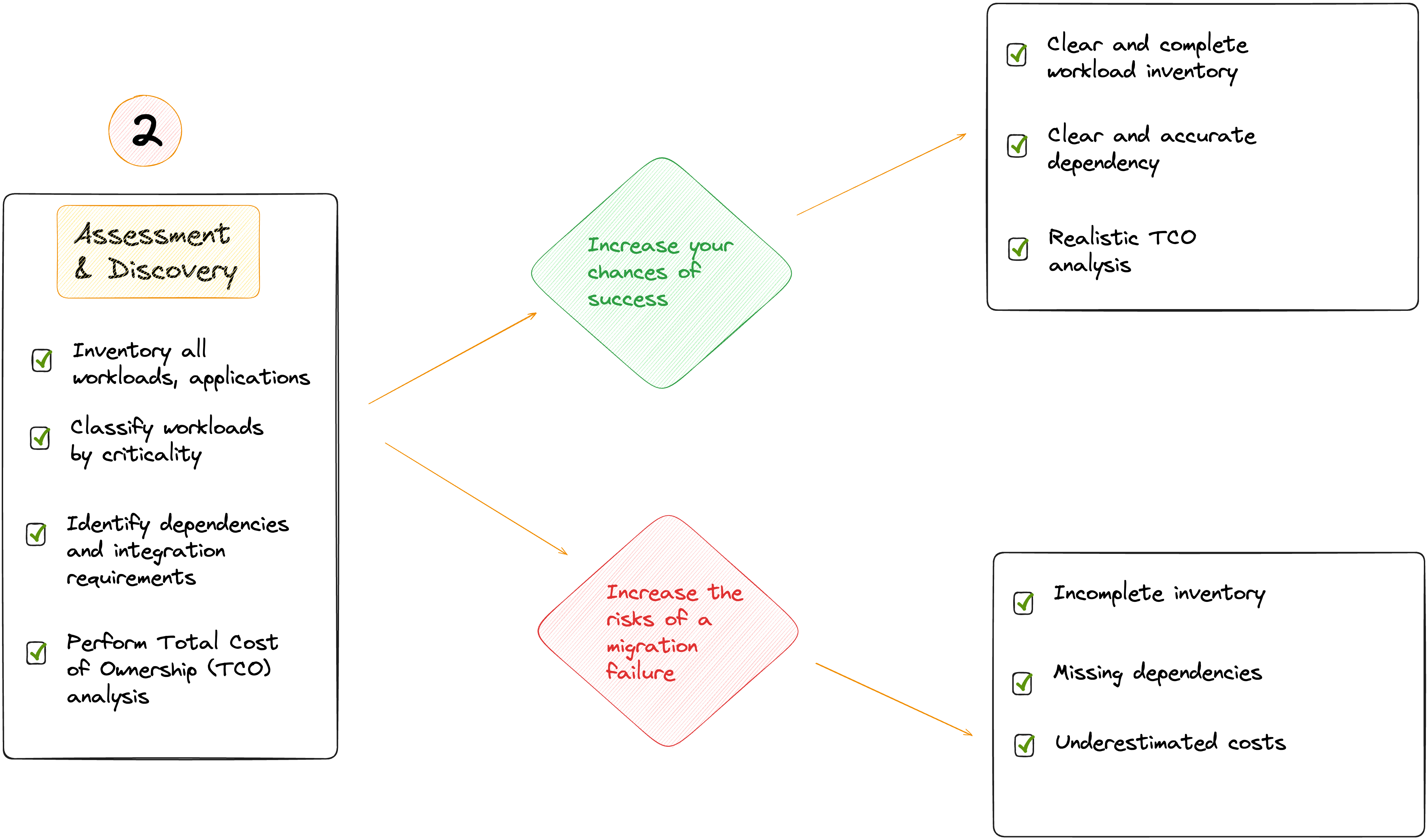
Design & Architecture
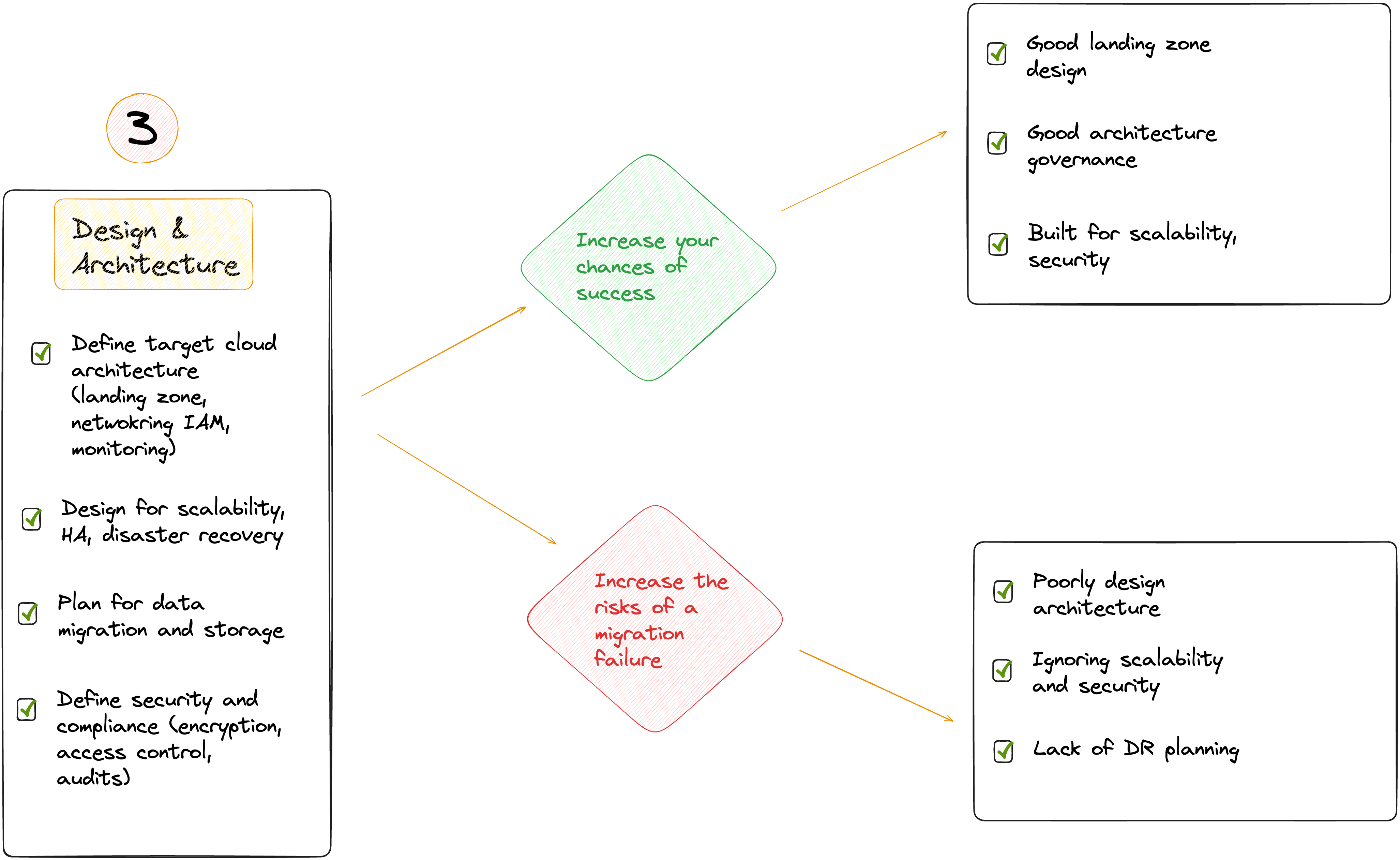
Pilot / Proof of Concept
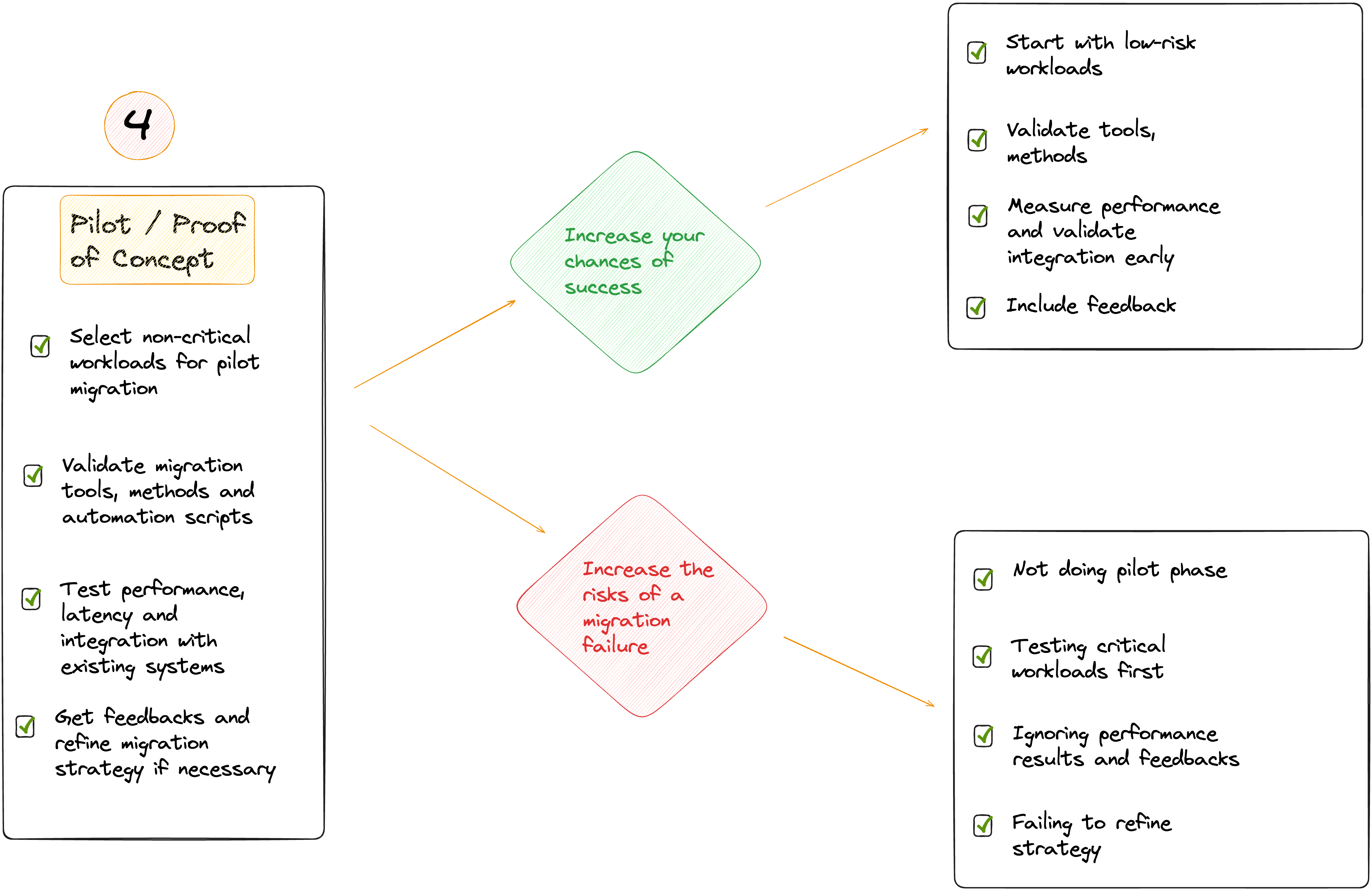
Migration Execution
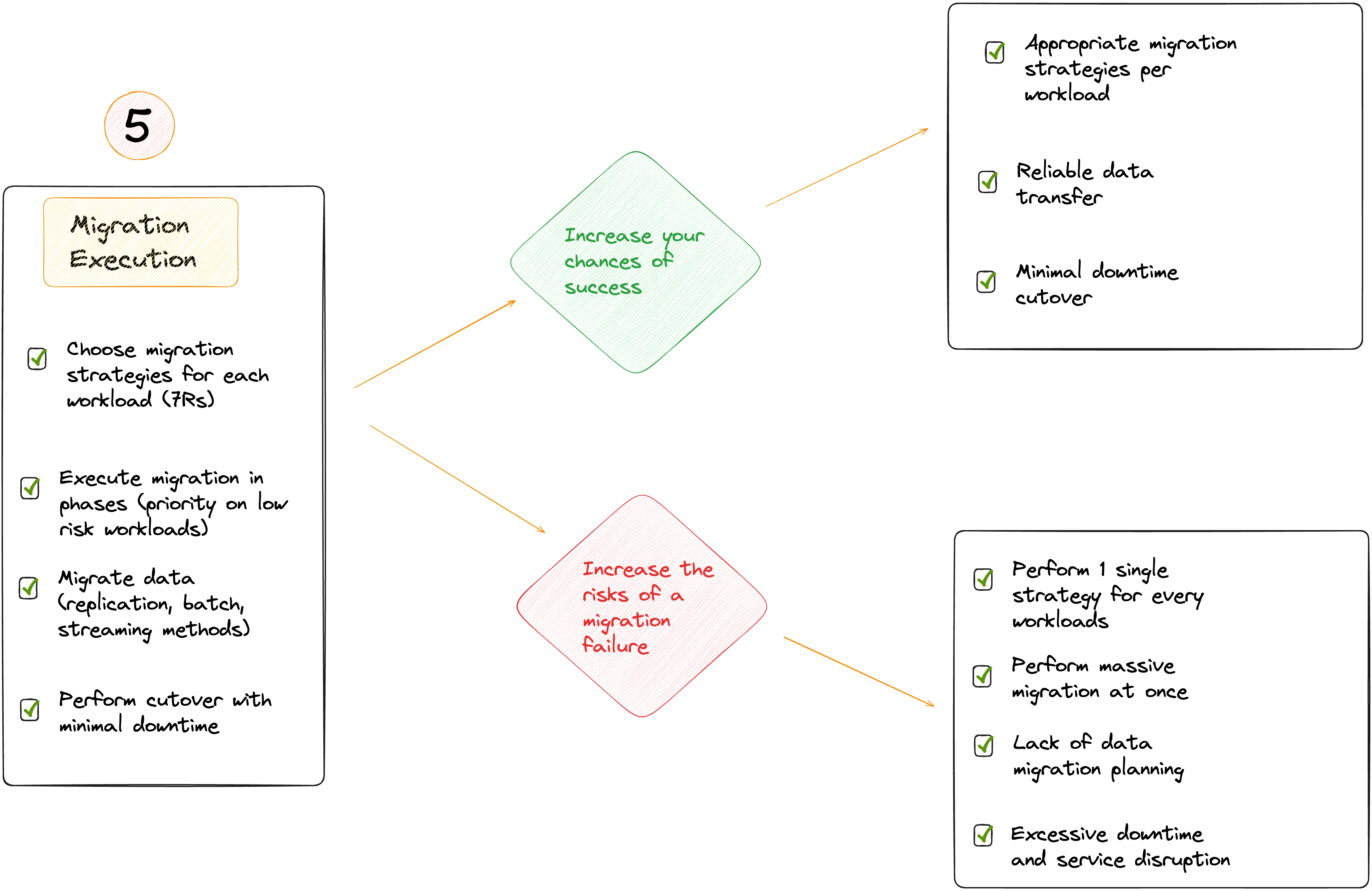
Validation & Optimization
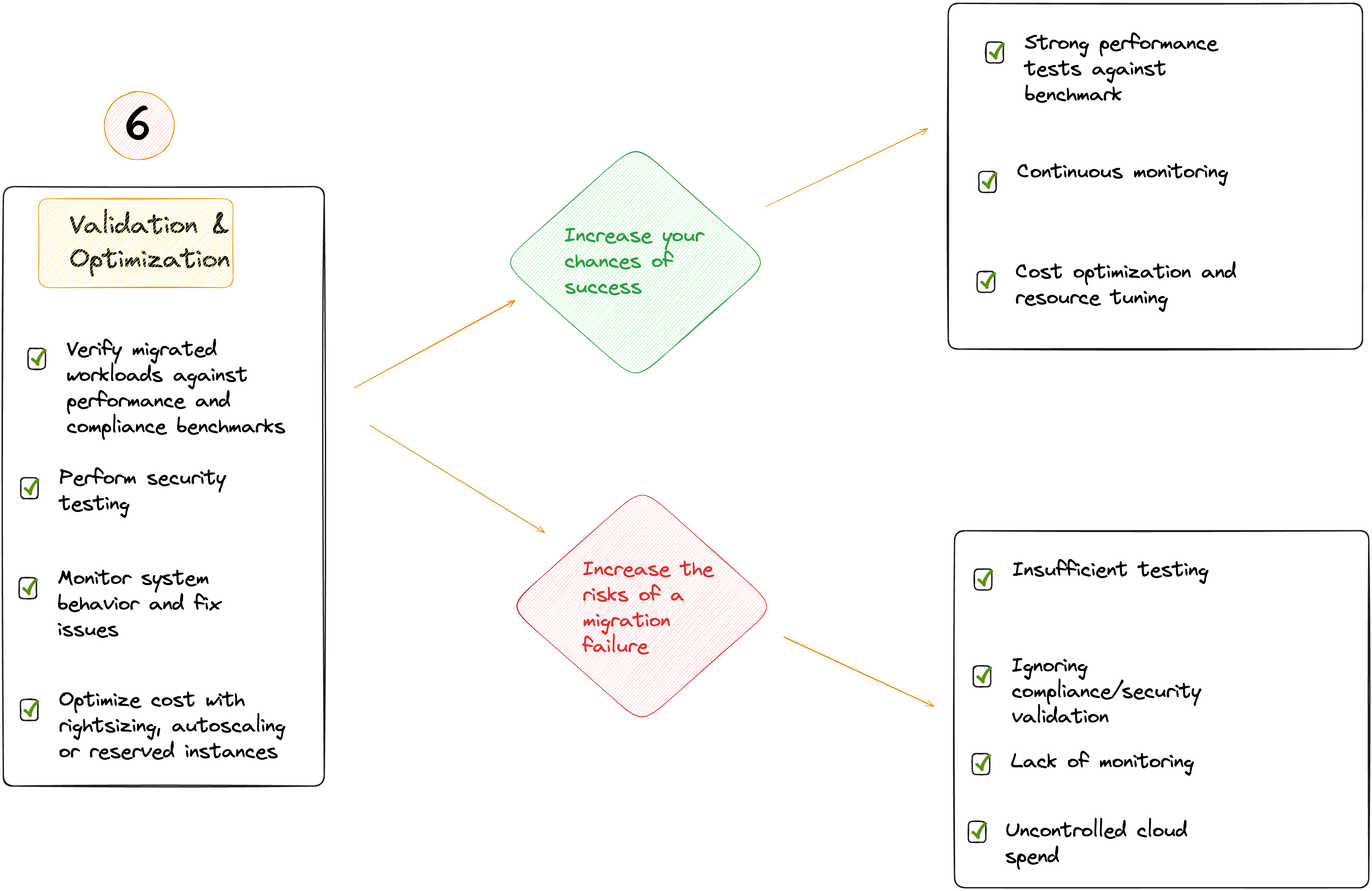
Operations & Continuous Improvement
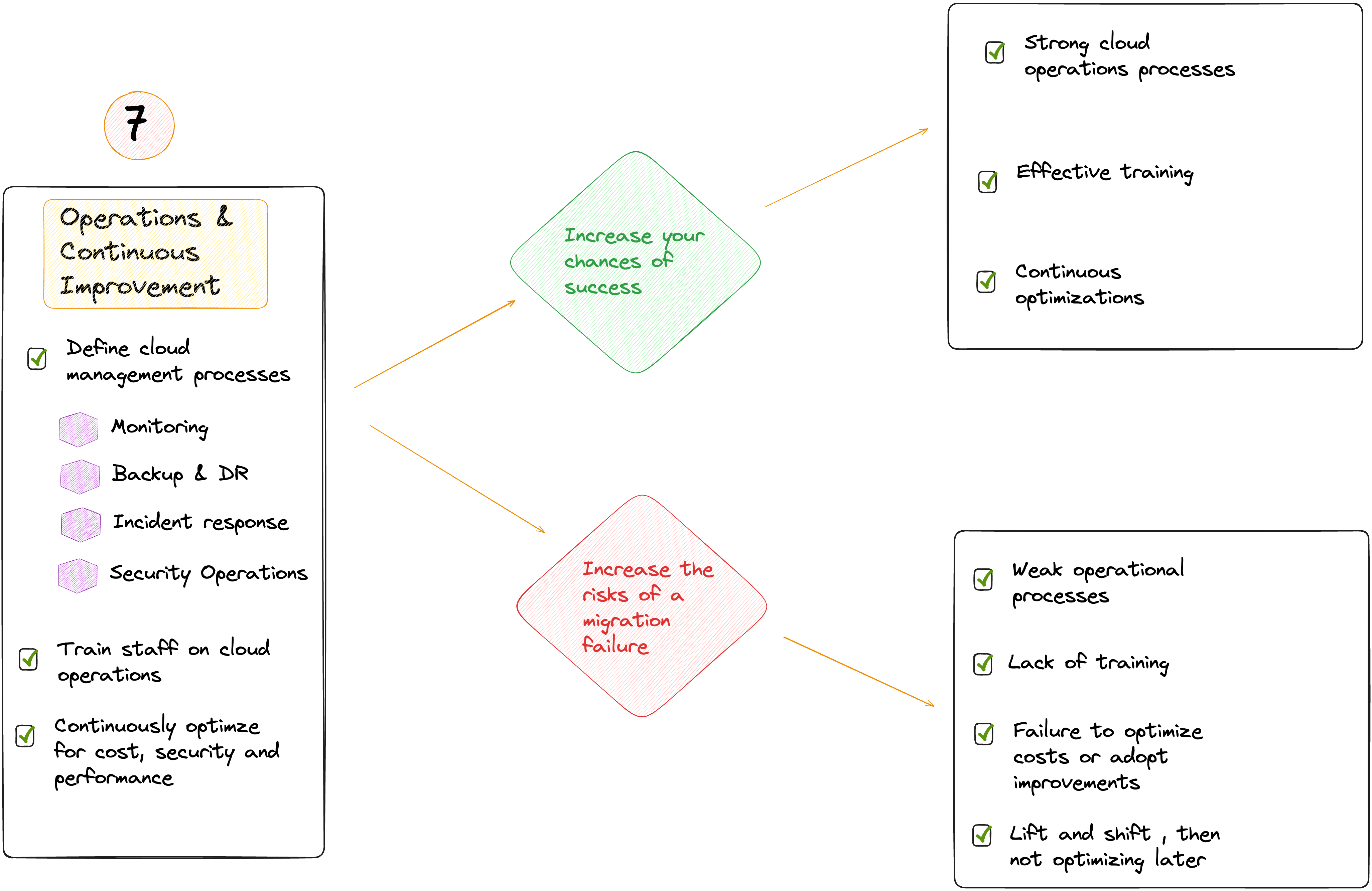
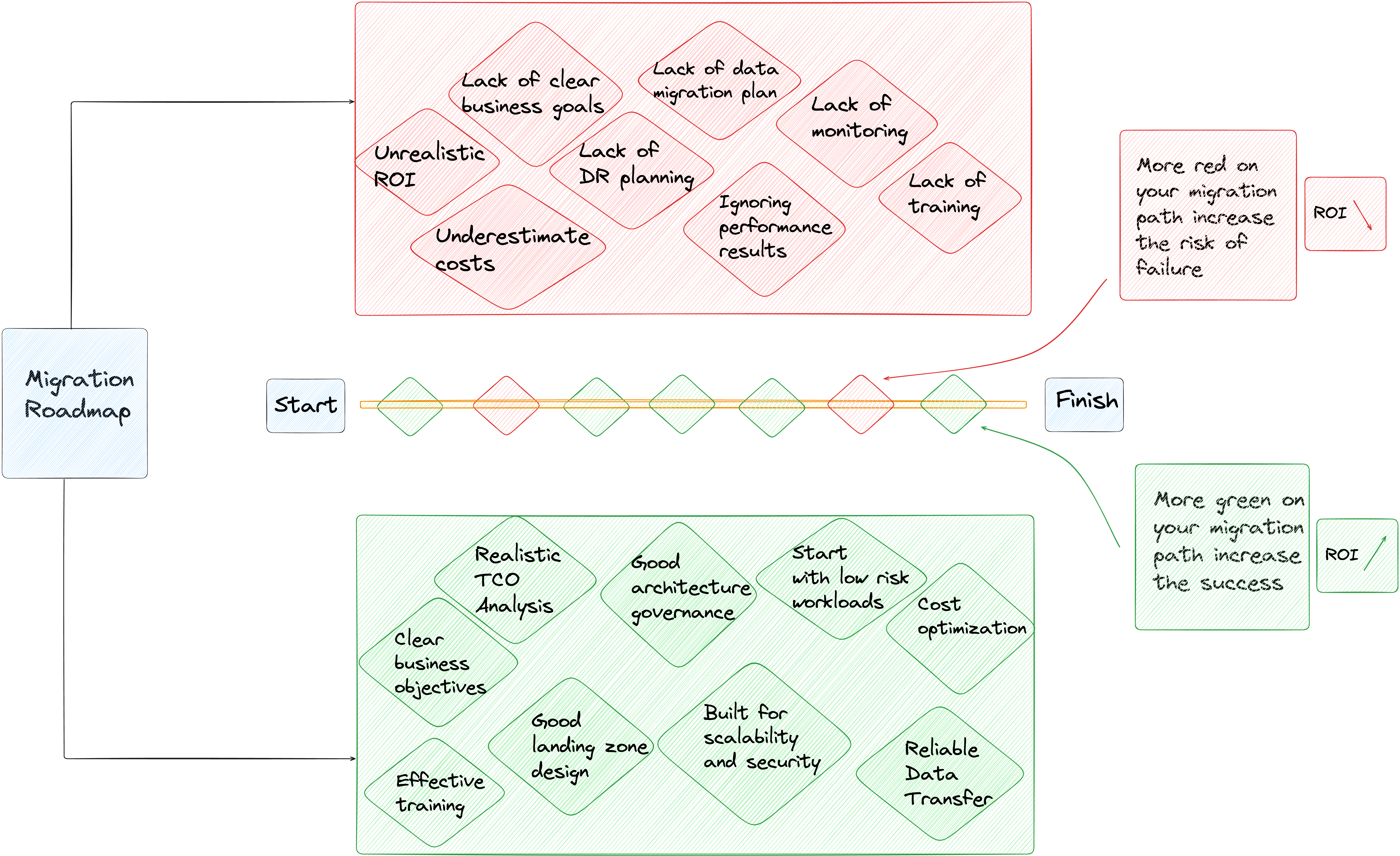
Cloud Migration Strategies - 7Rs
At the stage 5 (Migration Execution), you have the options to select which of your assets/workloads are suitable for a cloud migration or which one should be retired, or keep as-is.
You can choose between 7 cloud migration strategies, also known as the 7Rs
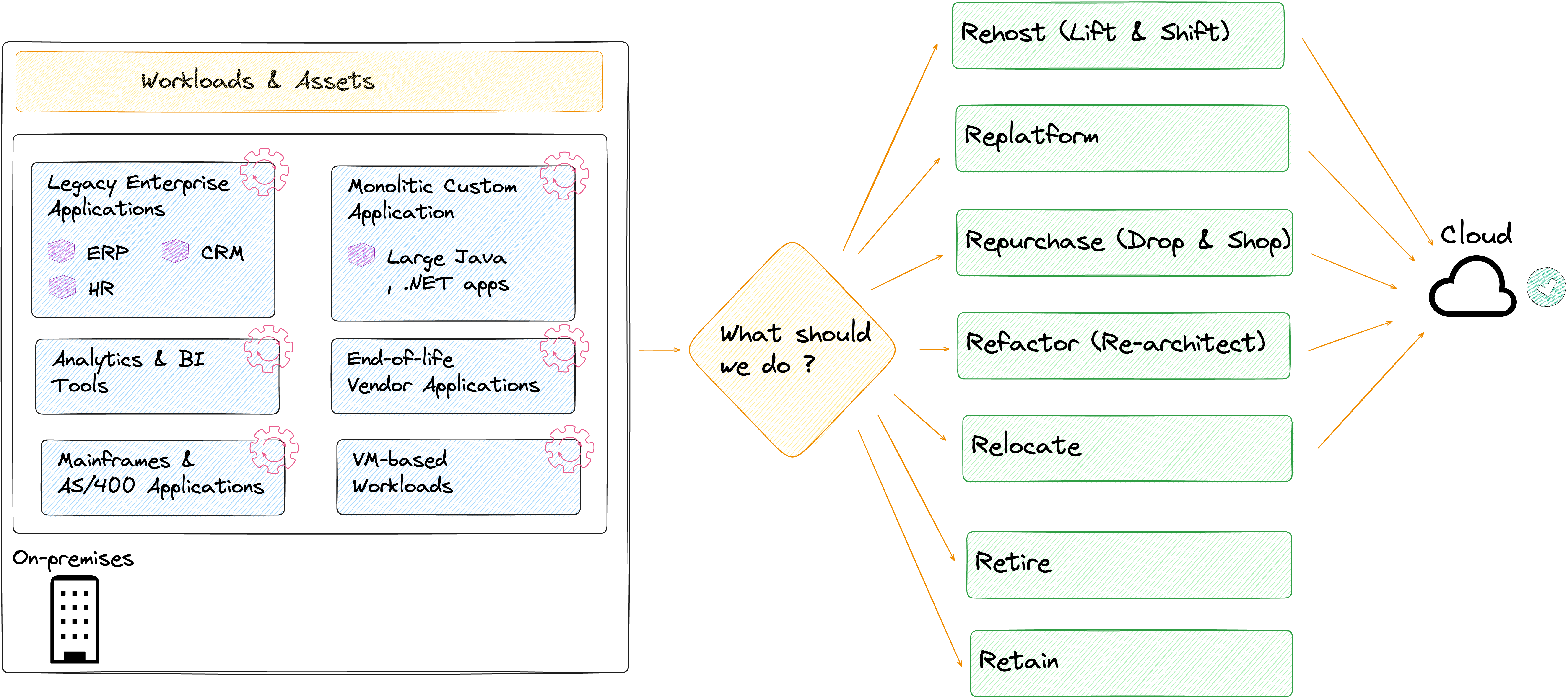
Here is the list of the cloud migration strategies and the potential Return on Investment (ROI) :
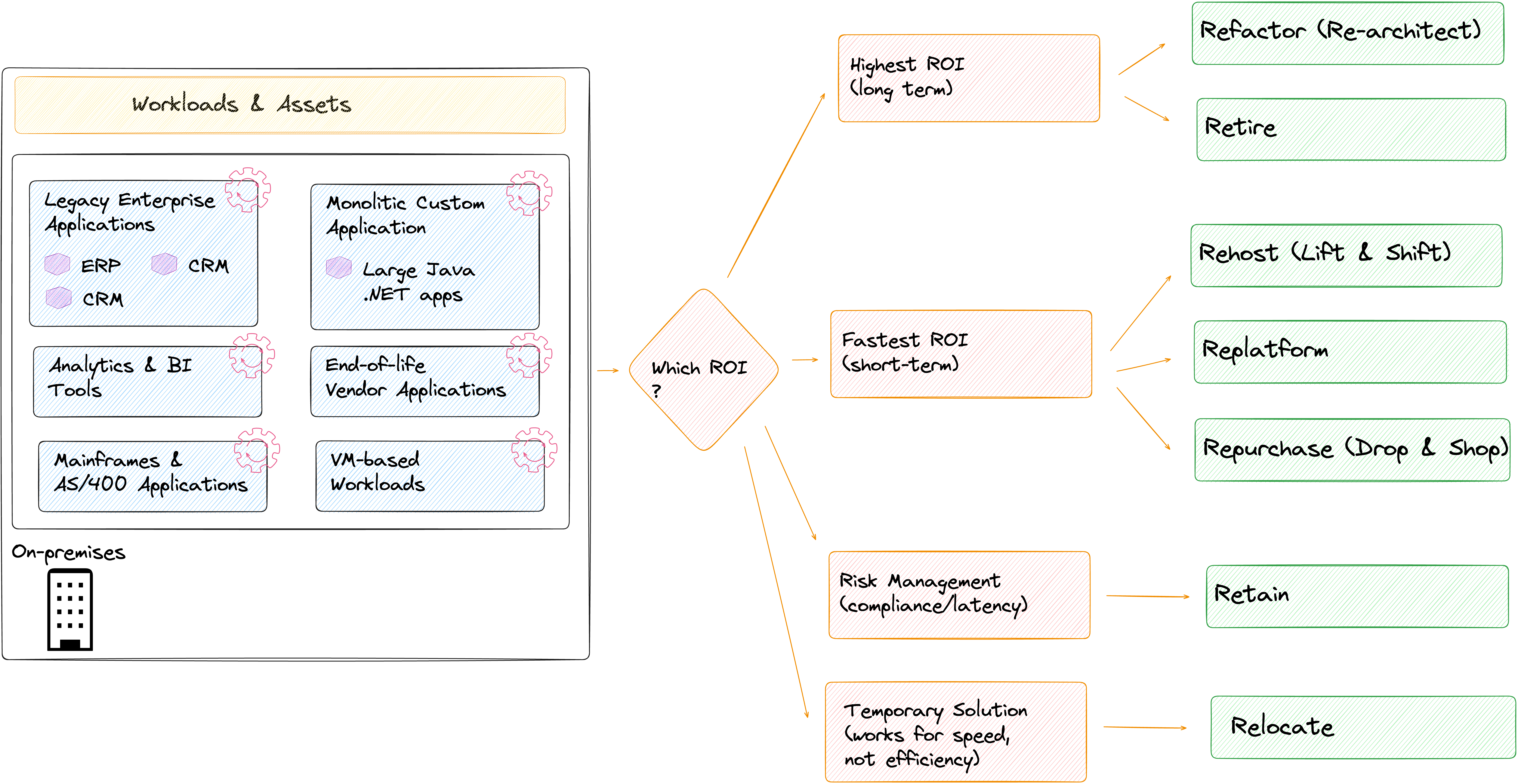
Rehost (Lift & Shift)
Objective : Move apps “as-is”
Typical use cases : Legacy systems needing fast migration
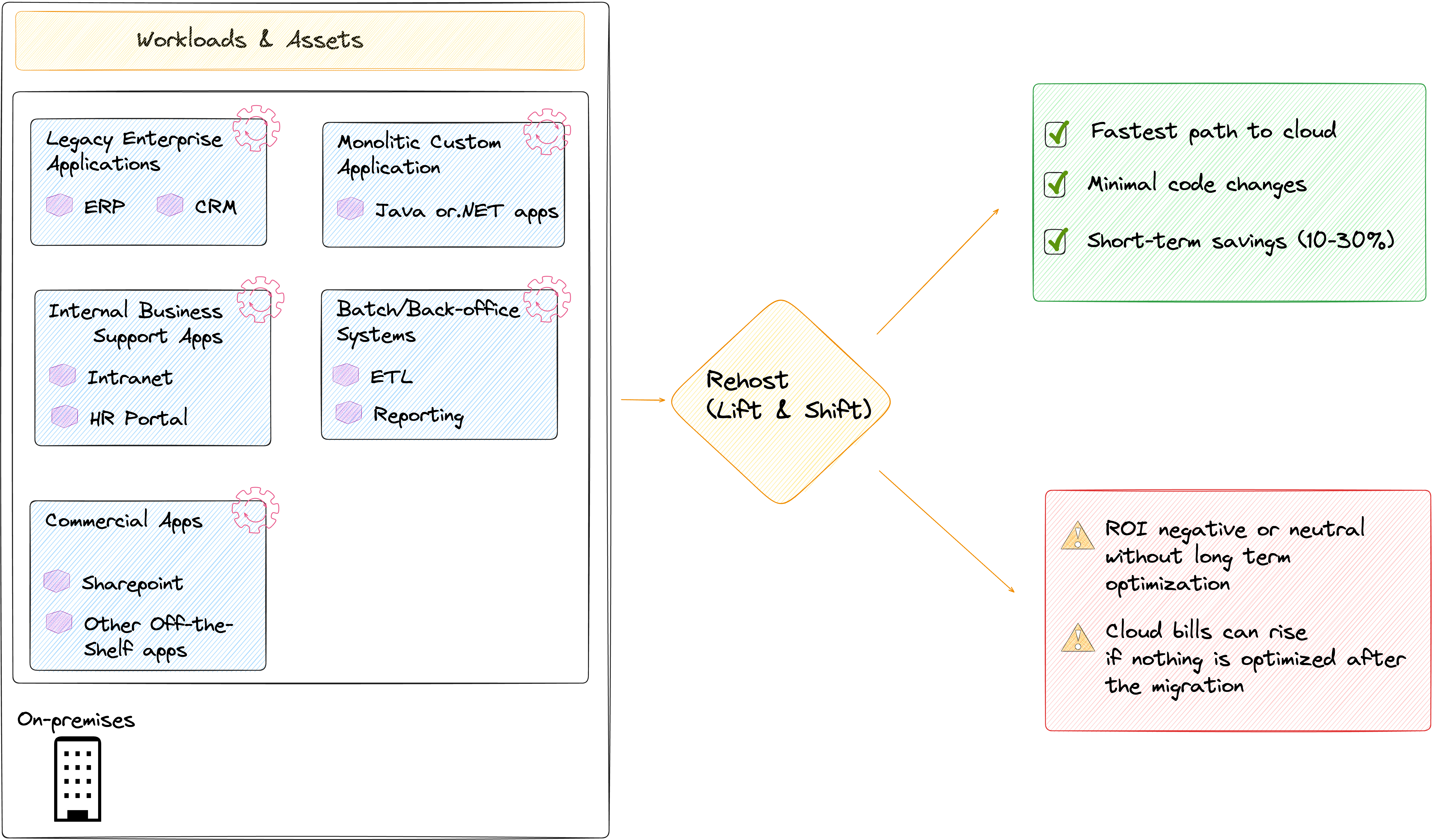
| Migration Strategies | Successfull Business Use Case | Warning Business Use Case |
|---|---|---|
| Rehost (Lift & Shift) |
GE Oil & Gas: Rehosted 500+ apps to AWS, achieving a 52% reduction in TCO Sources |
UK Government IT: Higher cloud bills than on-prem due to misaligned billing models Sources |
Replatform
Objective : Minor optimizations before move
Typical use cases : Apps that benefit from managed DBs, containers
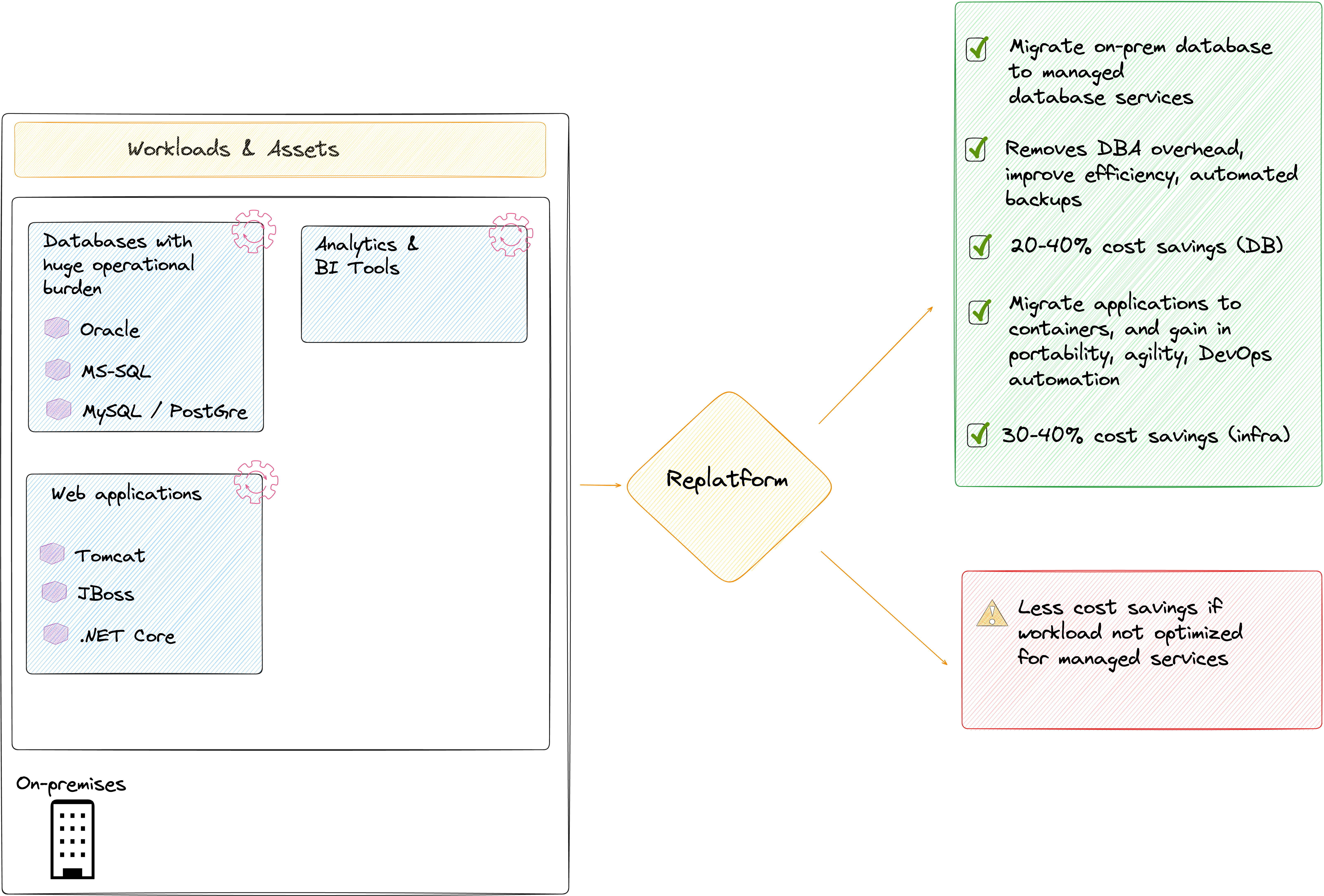
| Migration Strategies | Successfull Business Use Case | Warning Business Use Case |
|---|---|---|
| Replatform |
Airbnb: Migrated MySQL to Amazon RDS, reducing operational overhead. Sources |
Large retail company migrated its product database to a new DB system. After migration, the target system couldn’t interpret the data correctly from the source. This led to weeks of downtime, lost sales Sources |
Repurchase (Drop & Shop)
Objective : Replace legacy applications with SaaS
Typical use cases : Replace internal systems (CRM, ERP, HR, email) with SaaS (Salesforce, Office365, Workday etc ..)
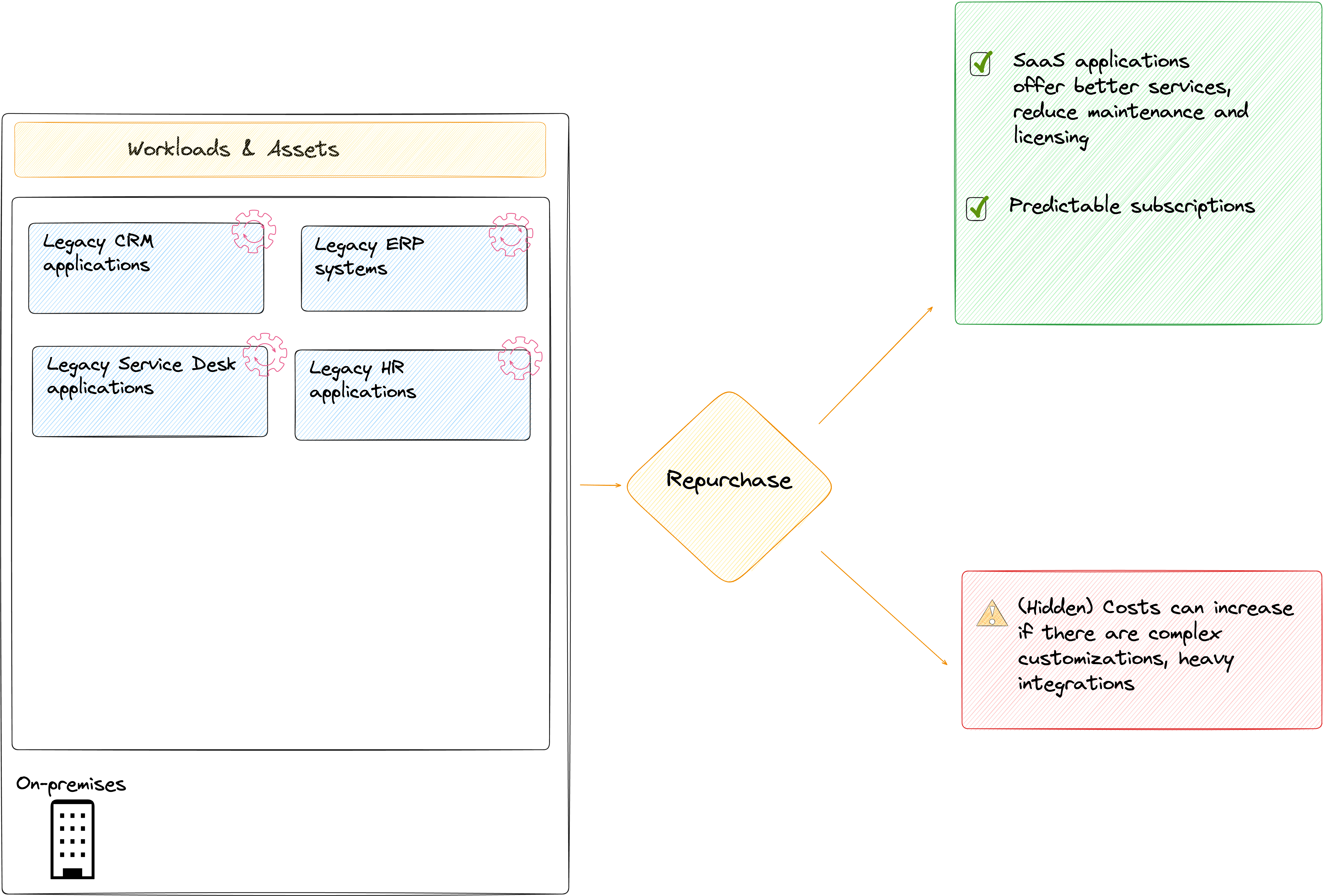
| Migration Strategies | Successfull Business Use Case | Warning Business Use Case |
|---|---|---|
| Repurchase |
Netflix : removed organizational silos, improved efficiency, and increased agility using SaaS solution (Workplace). Sources |
UK small insurance company : failed to deliver results, after migrating its traditional CRM system to a SaaS solution. , the source of the problem was related to technical/infrastructure issues and a misalignement with business needs Sources |
Refactor
Objective : Rewrite into cloud-native (microservices, serverless)
Typical use cases : Core business-critical systems, applications with high value that needs to be preserved but needs modernization to be efficient, secure and cloud optimized.
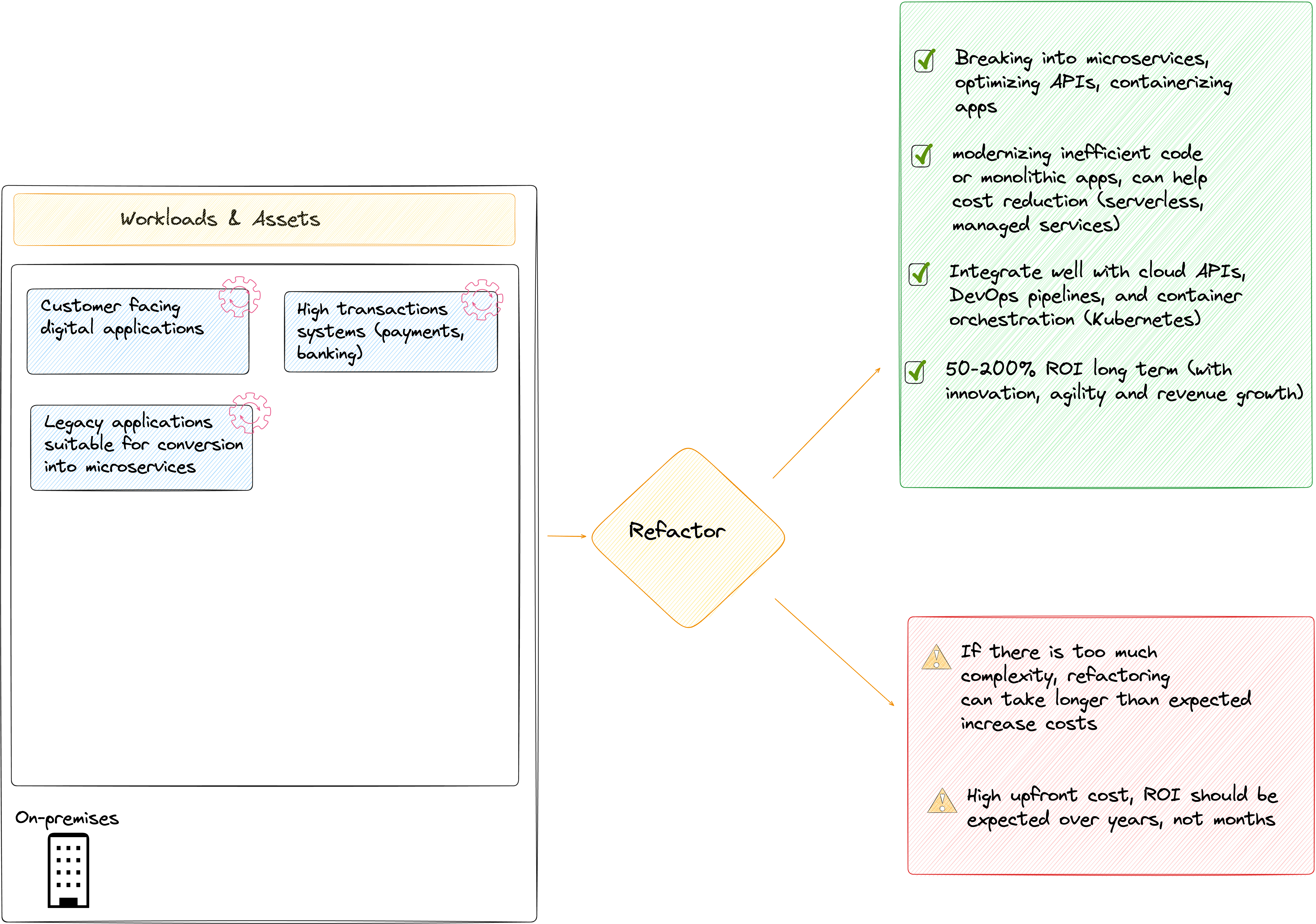
| Migration Strategies | Successfull Business Use Case | Warning Business Use Case |
|---|---|---|
| Refactor |
Capital One: Migrated major customer-facing apps to AWS, accelerating innovation Sources |
A company migrated 1,200+ apps to the cloud over 3 years, expecting cost savings and faster delivery. Part of that involved modernizing/refactoring some workloads. Infrastructure costs increased by ~34%, developer productivity dropped, shadow IT rose because teams couldn’t work effectively inside the new governance Sources |
Retire
Objective : Decommission applications.
Typical use cases : Decommission applications with low value, redundant systems
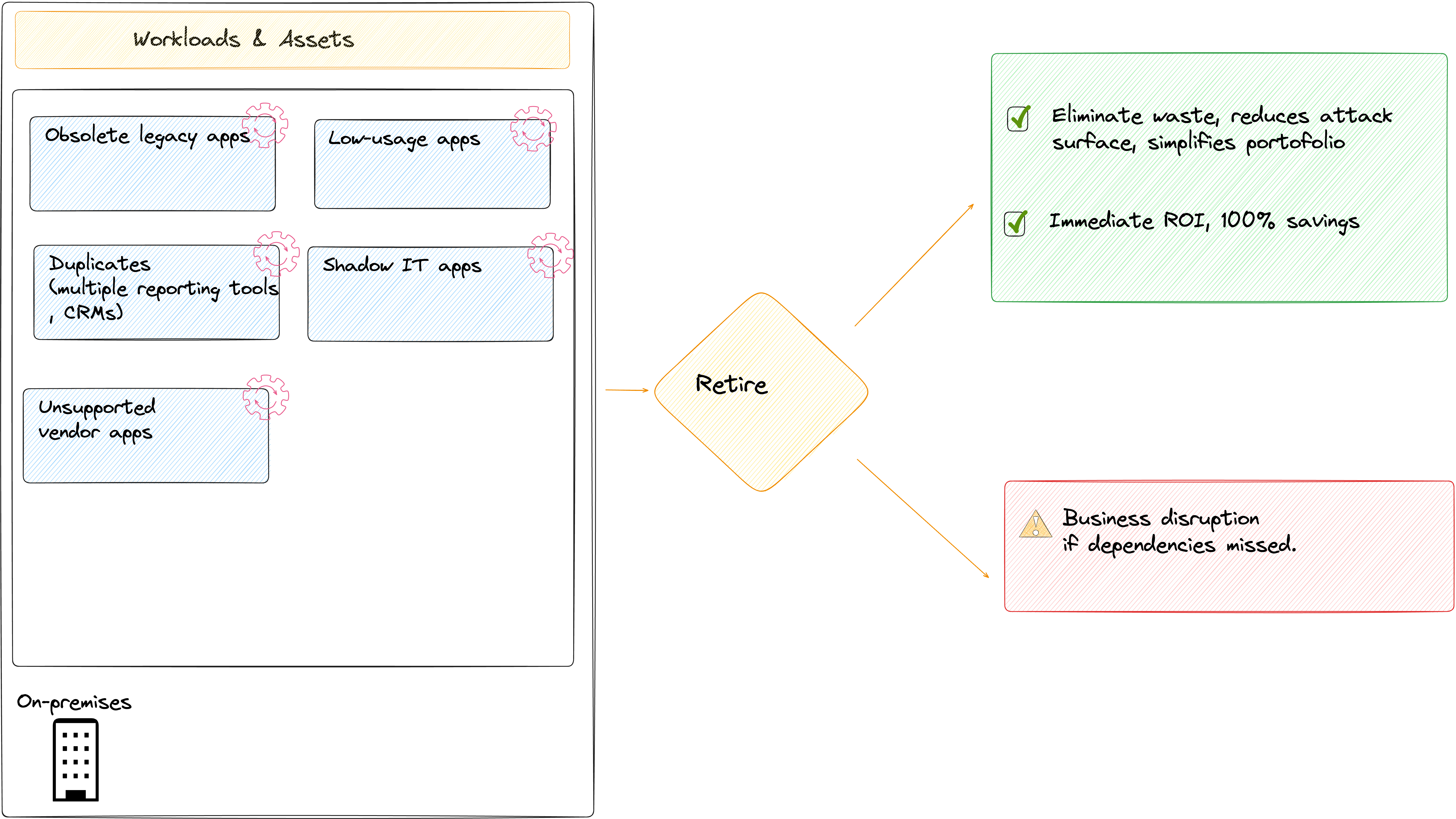
| Migration Strategies | Successfull Business Use Case | Warning Business Use Case |
|---|---|---|
| Retire |
Autodesk : Retired 209 application environments during its migration / modernization. Achieved reduced attack surface, better efficiency, automation, and improved security. Also migrated many other apps with high cost-efficiency (~97 %) Sources |
Bank Reporting App: Retired app led to compliance failures due to missed dependencies. |
Retain
Objective : Keep applications on-prem for now, because moving them doesn’t make sense from a cost, complexity, compliance, or technical perspective
Typical use cases : Regulated, latency-sensitive workloads
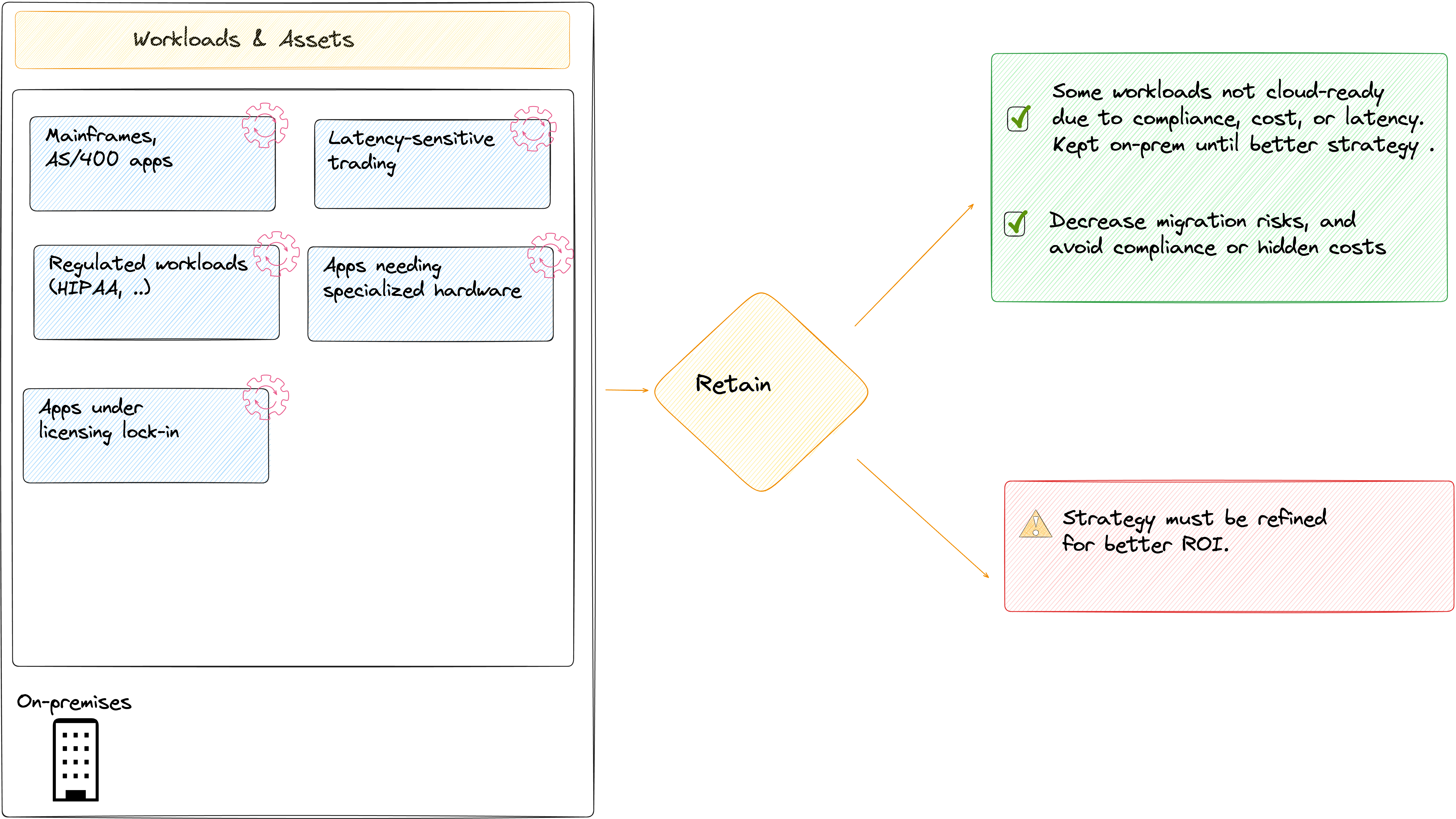
| Migration Strategies | Successfull Business Use Case | Warning Business Use Case |
|---|---|---|
| Retain |
Johnson & Johnson : Implemented a hybrid cloud strategy, retaining certain legacy applications on-premises while migrating others to AWS. This approach allowed them to maintain control over critical systems and comply with regulatory requirements. Sources |
Oil & Gas Industry : The company retained some critical legacy systems on-premises while exploring or partially adopting cloud for other workloads. The challenges they faced (resistance, integration complexity, organizational impact) are common risks of hybrid environments, which arise when some apps are retained and others are migrated Sources |
Relocate
Objective : Move VMs/clusters without code change
Typical use cases : Data center exits, Time-senstive migration
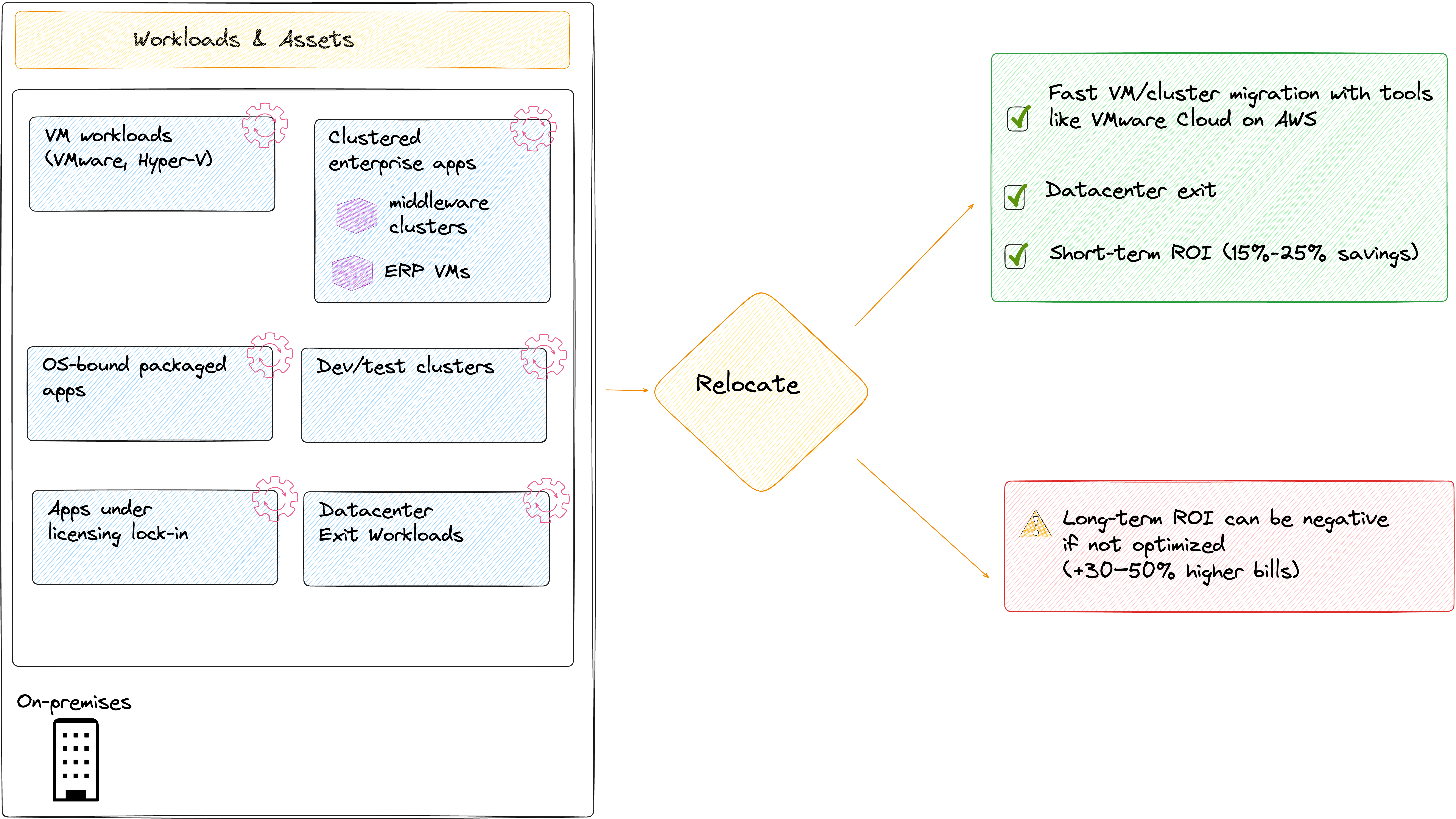
| Migration Strategies | Successfull Business Use Case | Warning Business Use Case |
|---|---|---|
| Retain |
Martin Currie: Saved money and sped up development by migrating Windows workloads to AWS, moving to a partial operating expenditure model to lower longer-term costs by as much as 30%. Sources |
Pharma Brand : Migrated SAP S/4HANA to Databricks Lakehouse; encountered issues with siloed data from both ERP and non-ERP systems, preventing the company from utilizing the full potential of its vast data assets Sources |
CCOE (Cloud Center of Excellence)
Migrating to the cloud can bring many challenges. You have to prepare, plan , perform the migration while maintaining current activities. As illustrated in the following diagram, what people/organization often understimate is their internal organizational culture.
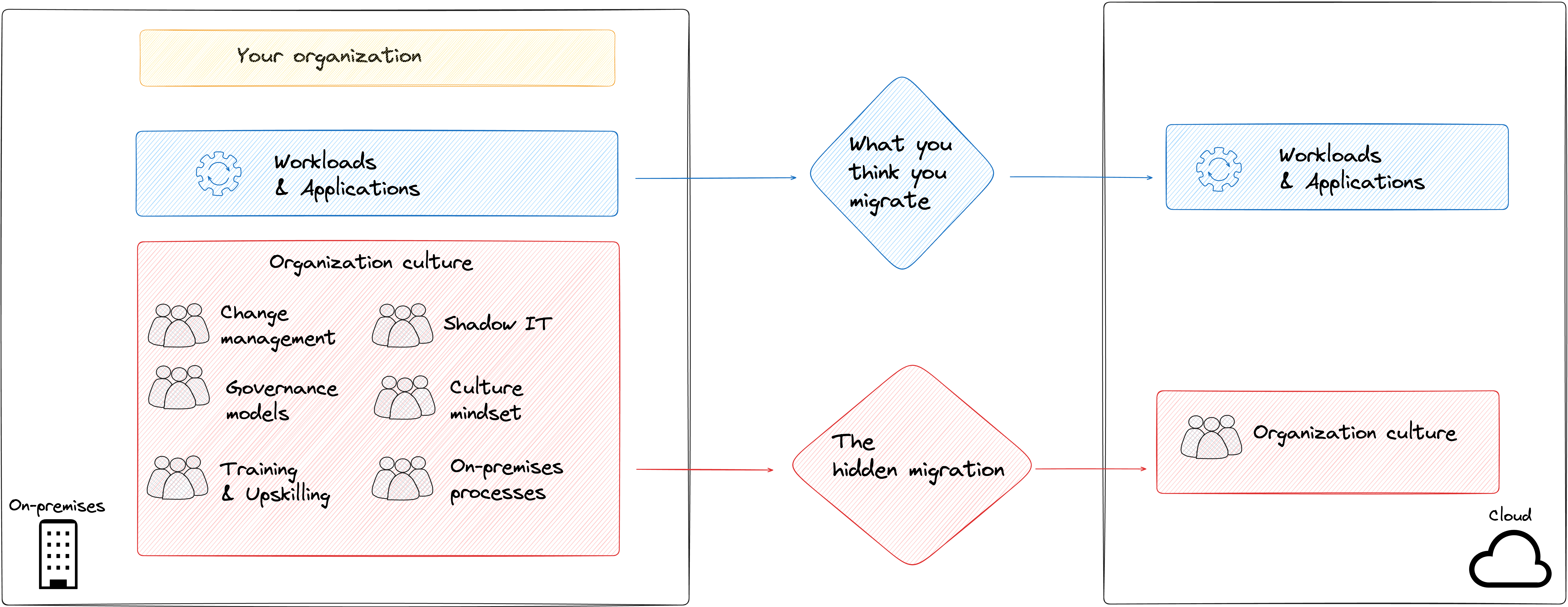
Cloud providers often recommend to create a special team of specialists and experts, a cross-functional team within your organization responsible to drive the cloud adoption, ensuring the governance and best practices.
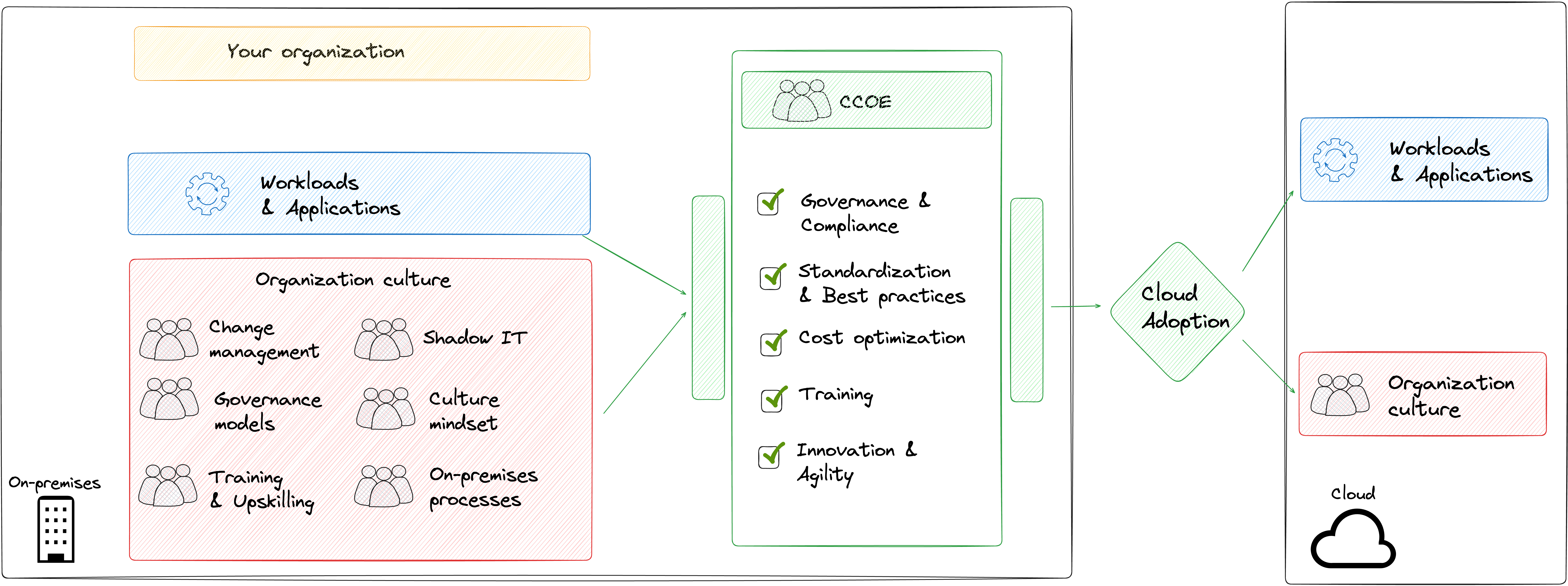
Real-world cases where a lack of CCoE caused revenue loss
| Company | Incident Description | Revenue / Impact | Root Cause / Lessons | Sources |
|---|---|---|---|---|
| Netflix (2008–2010) | Rapid AWS adoption without centralized cloud governance caused uncoordinated deployments and repeated outages. | Customer dissatisfaction, service interruptions, and lost subscriptions. | No CCoE to standardize cloud architecture, enforce best practices, and oversee cost/operational governance. | More details |
| Capital One (pre-2018) | Misconfigurations in cloud resources caused over-provisioning and contributed to the 2019 breach. | $190 million in fines/settlements and reputational damage. | Lack of centralized cloud security and governance structure; no mature CCoE at the time. | More details |
| Airbnb (2014–2015) | Independent team cloud deployments caused inefficiencies, high costs, and inconsistent monitoring. | Significant hidden cloud costs, delayed feature rollouts, and operational inefficiencies. | No CCoE to enforce cost visibility, tagging, and cloud best practices. | More details |
| Uber (pre-2016) | Teams independently deployed large services on AWS; cost overruns and performance issues were common. | Increased infrastructure spend and slower product delivery. | Absence of a CCoE to manage governance, cost optimization, and reliability standards. | More details |
| General Electric (early 2010s) | Multiple cloud initiatives ran in silos across divisions; duplication of cloud resources, inconsistent security, and slow migrations. | Multi-million-dollar wasted cloud spend and delayed digital initiatives. | No enterprise-wide CCoE to standardize cloud practices and optimize costs. | More details |
| Equifax (pre-2017 cloud adoption) | Siloed cloud adoption and inconsistent security policies contributed to the massive 2017 breach. | $1.4 billion+ in breach costs, fines, and reputational damage. | No centralized cloud governance structure or standard policies; a CCoE could have enforced them. | More details |
Cloud Migration Failures Scenarios
Here is a list of scenarios you can learn from :
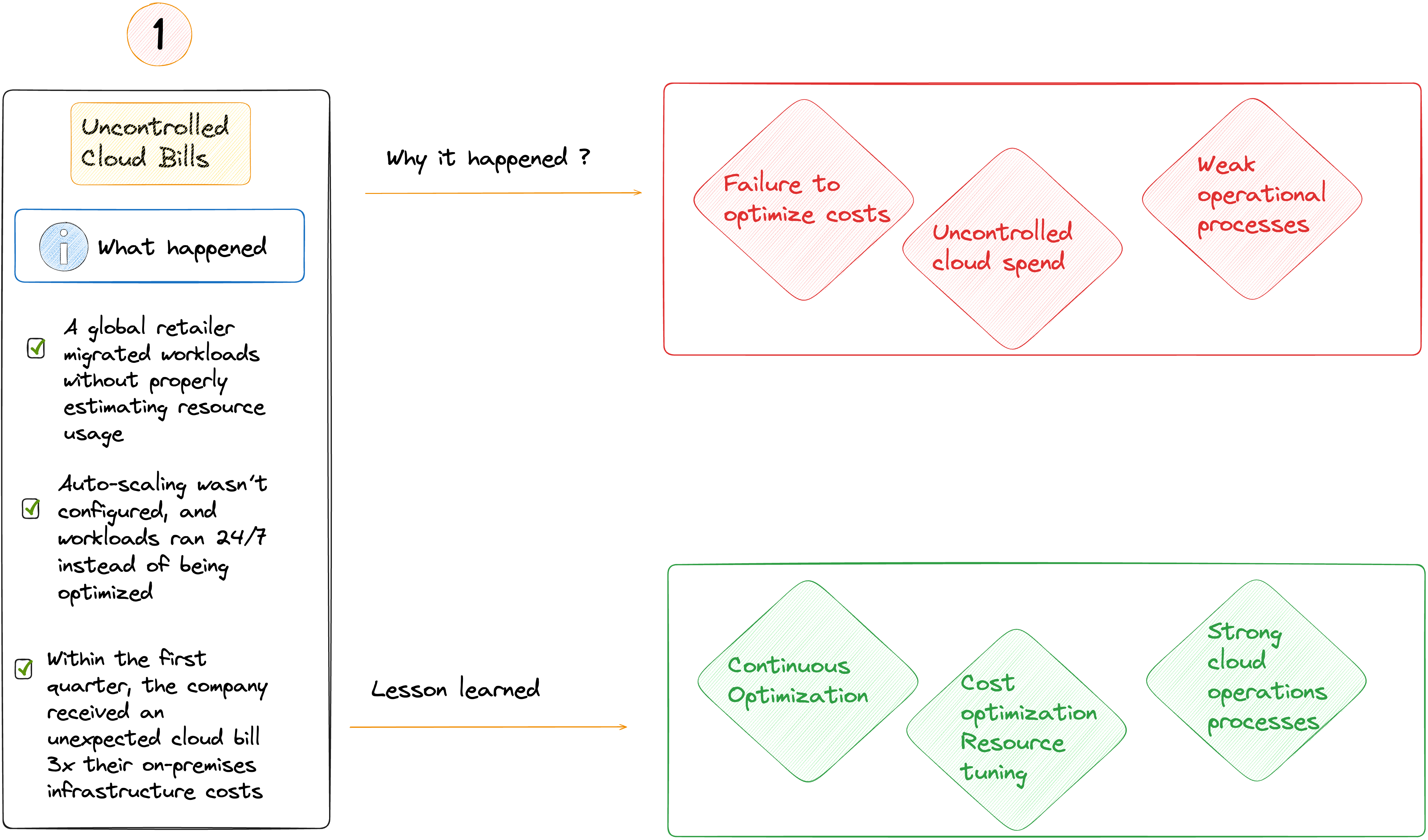
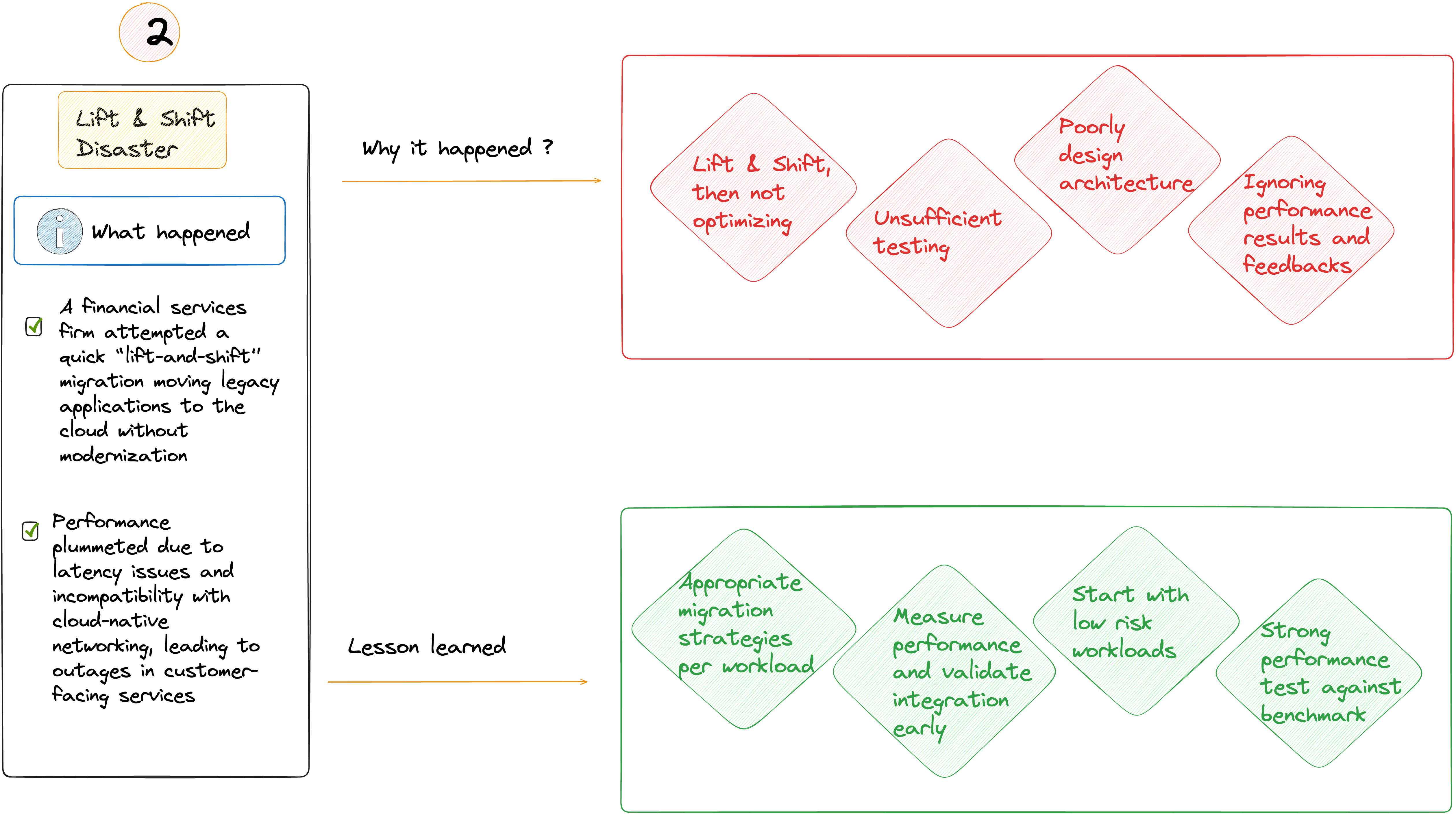
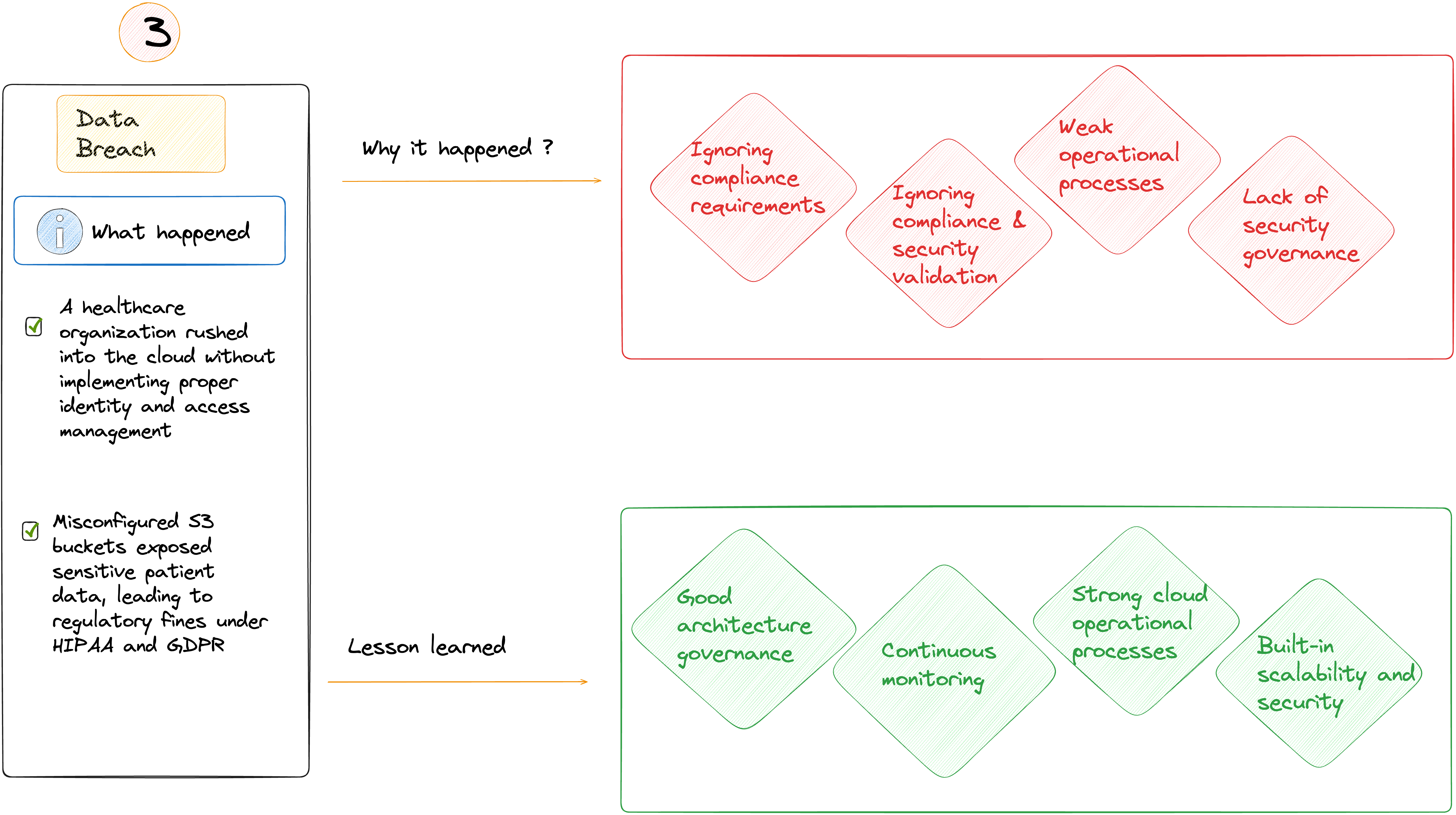
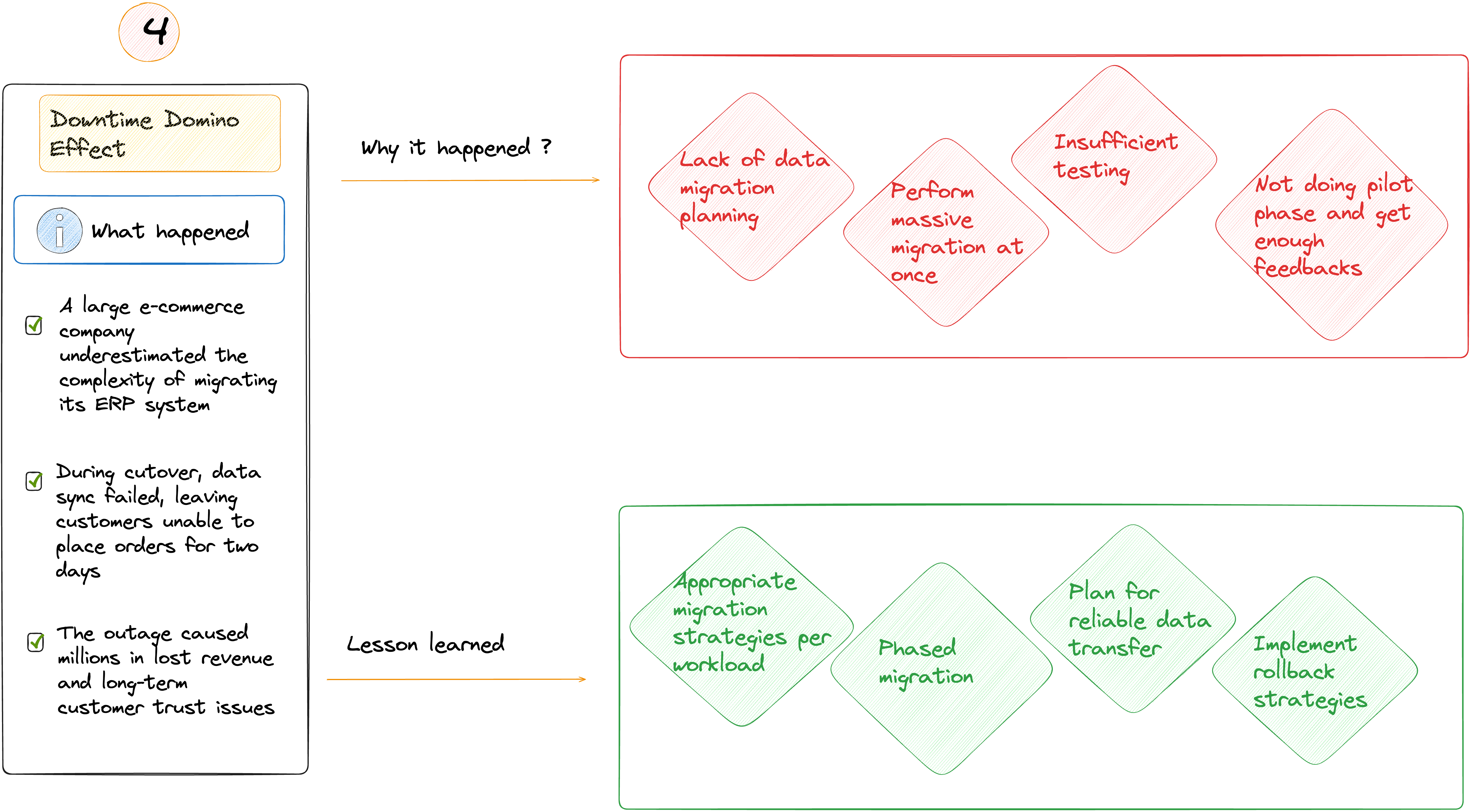
Cloud Migration Roadmap - Decreasing the Risks
Things will always go wrong because there are always exceptions, unexpected events, constraints, trade offs, etc..
The perfect migration is unrealistic, but what can be done is assessing and identifying the risks on your migration path, and try to correct the trajectory as early as possible.
After each phase, it might be worth pausing, reflecting, decreasing the risks, and improving the chances for a successful migration.
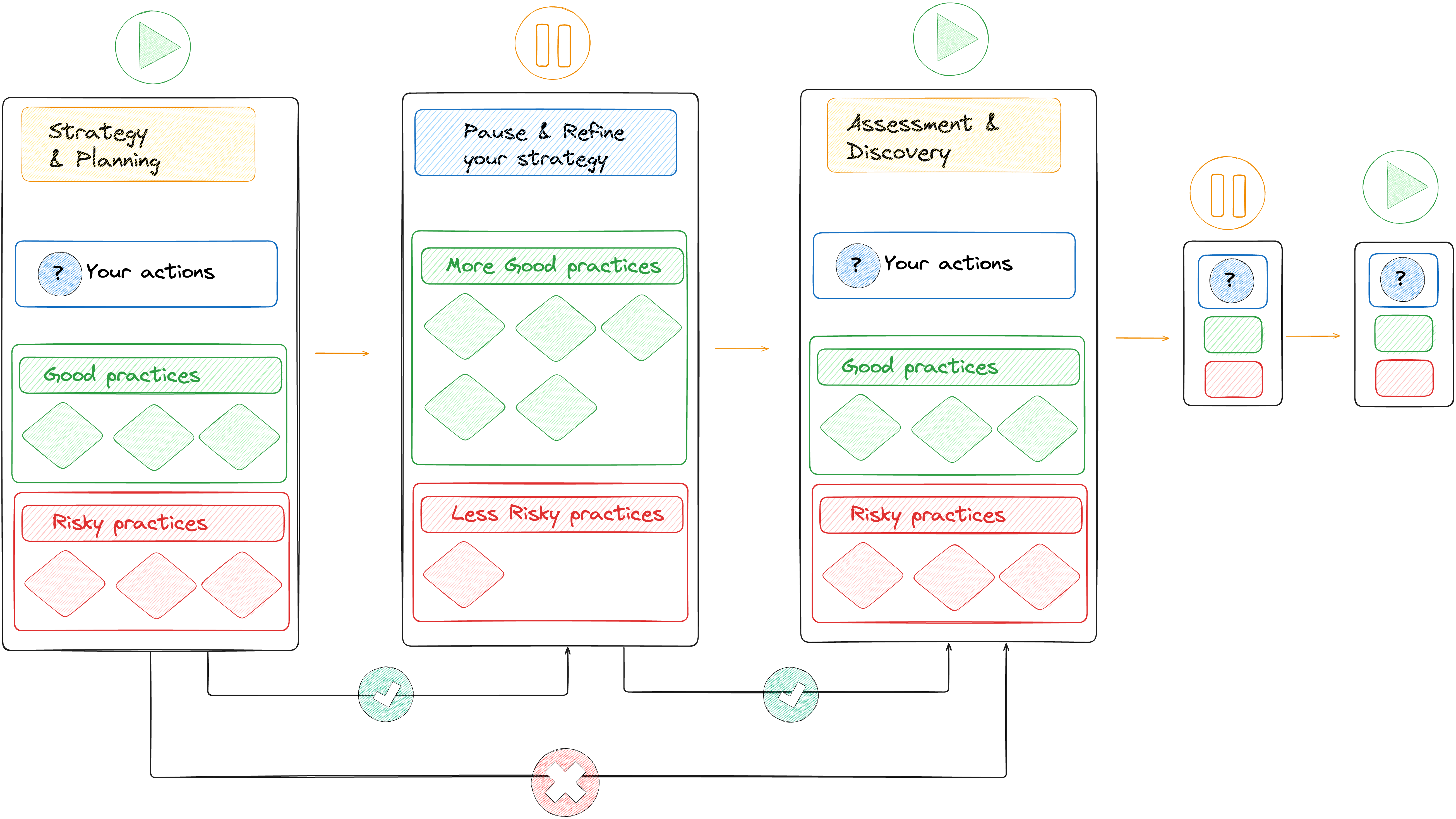
Realworld business use cases
"The essence of risk management lies in maximizing the areas where we have some control over the outcome while minimizing the areas where we have absolutely no control over the outcome and the linkage between effect and cause is hidden from us."
(Peter L. Bernstein)
Your cloud migration is unique, because you have a unique business, a unique culture, your challenges, despite what people may recommend you, are unique.
The migration roadmap should not be a copy/paste playbook, but rather a compass to help you navigate, pause, reflect, re-assess your plan, to lower the risks of a migration failure and increase the chances for a migration success.
It's always safe to learn from other companies and see whether their use cases and challenges can be an inspiration for your own business goals.
| Companies | Industry | Business Use Cases | Return on Investments/Benefits | Migration Time / Duration | Sources |
|---|---|---|---|---|---|
| Capital One |
Banking & Financial |
Data Center Exit |
Significant infrastructure cost savings Reduced Power & Cooling Faster provisioning & Improved agility |
5-8 years |
More details |
| Hilti |
Energy & Industry Solutions |
ERP Modernization / SAP migration |
112 % ROI over three years reduced time-to-market & lower TCO Faster provisioning & Improved agility |
9-36 months |
More details |
| Netflix |
Media & Streaming services |
App Modernization / Microservices refactor |
Improved deployment velocity Easier scaling Reduced technical debt over time |
6–18 months |
More details |
| Airbnb |
Hotels & Hosting |
Big Data / Analytics migration |
Faster insights Scalable storage Reduced datawarehouse cost |
6–12 months |
More details |
| Etsy |
Ecommerce |
E-Commerce Platform Migration |
Faster insights Improved reliability Cost avoided from overprovisioning |
~2 years (5.5 PB data migrated) |
More details |
| Etsy |
Ecommerce |
Higher productivity |
Lower overhead in managing infrastructure Companies shifting to SaaS tools (e.g. Office 365, Google Workspace) Lower deployment burden |
12–24 months |
More details |